

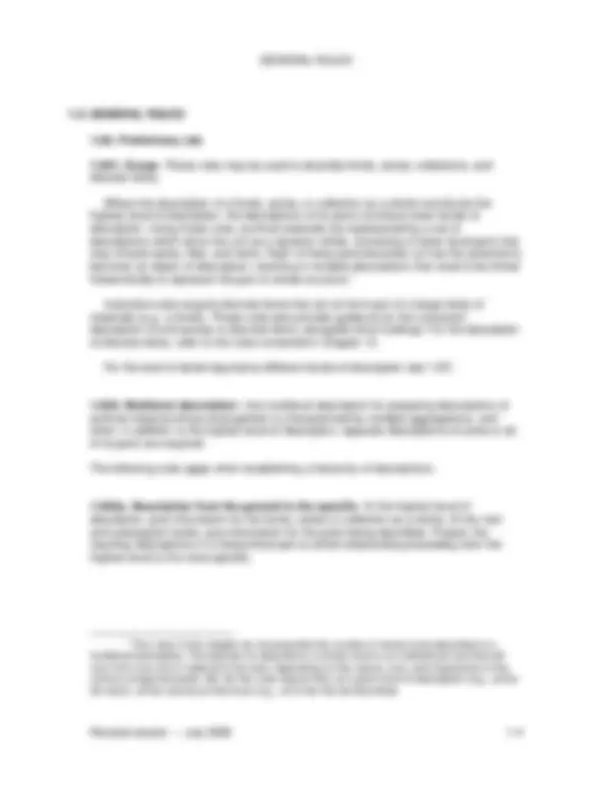
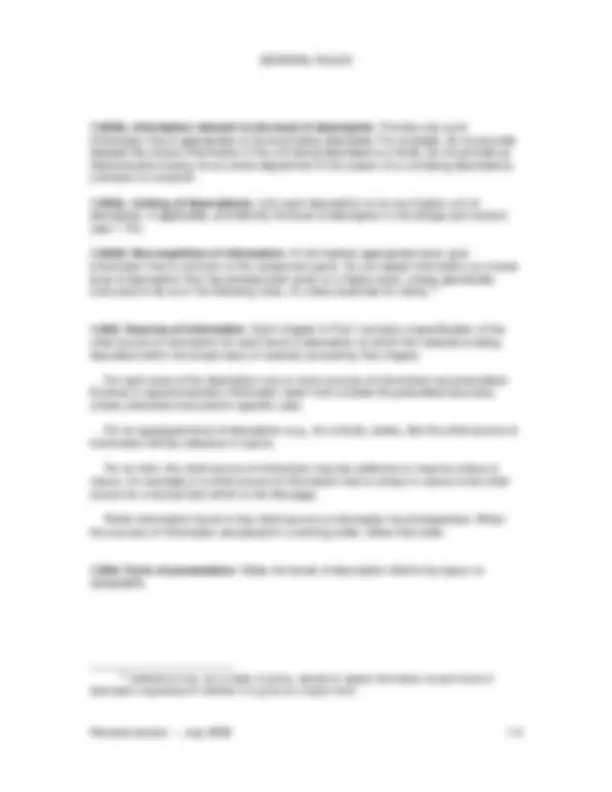
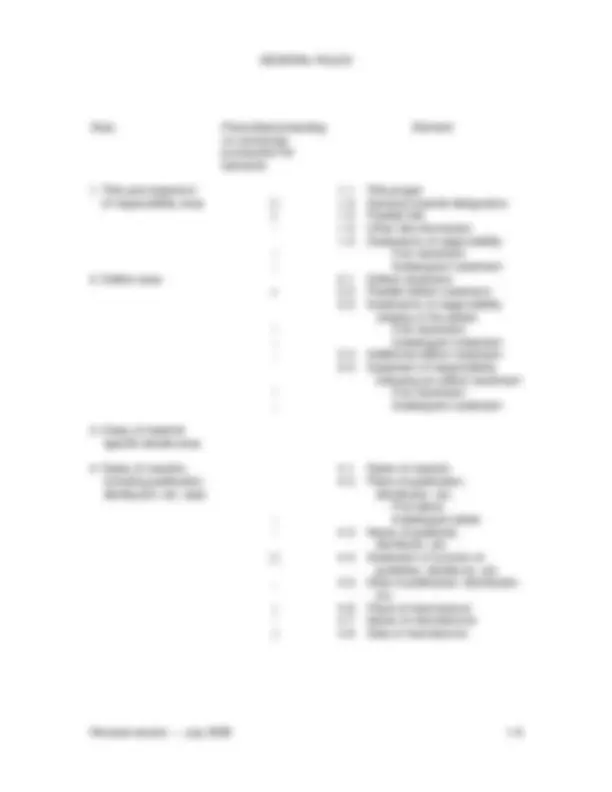
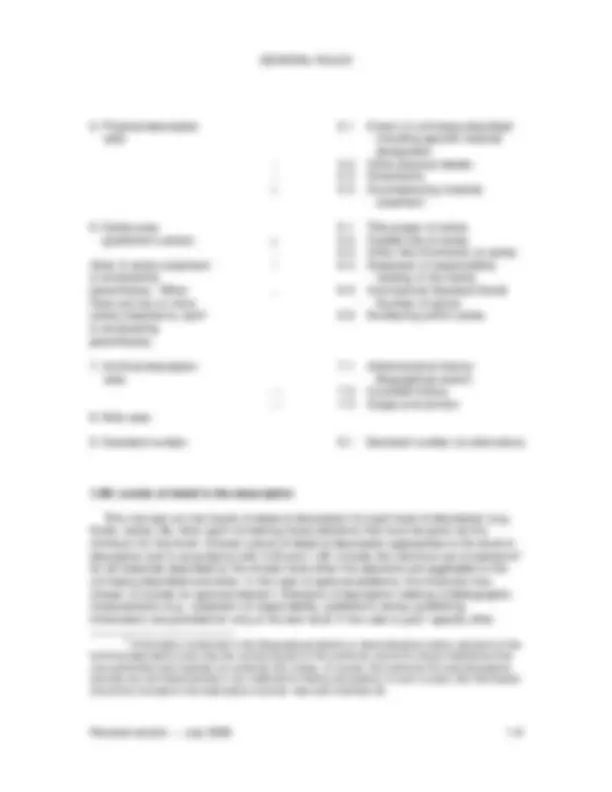
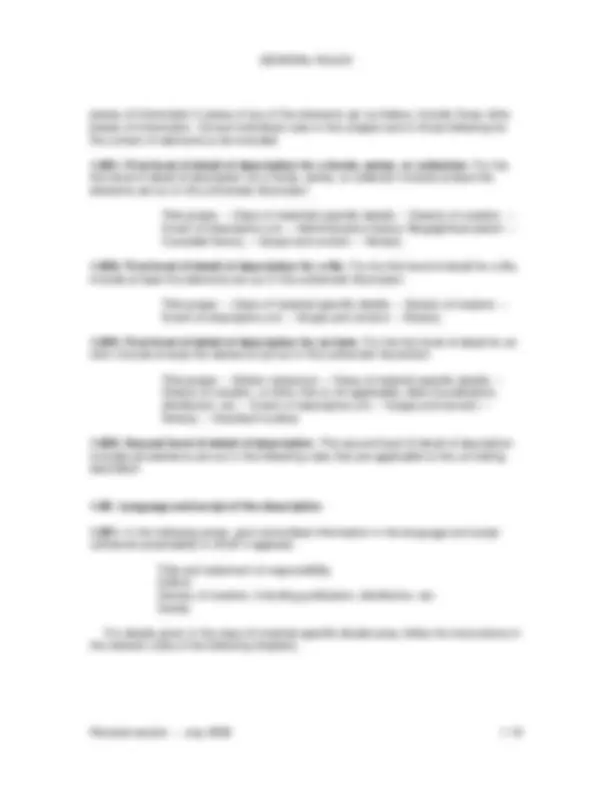
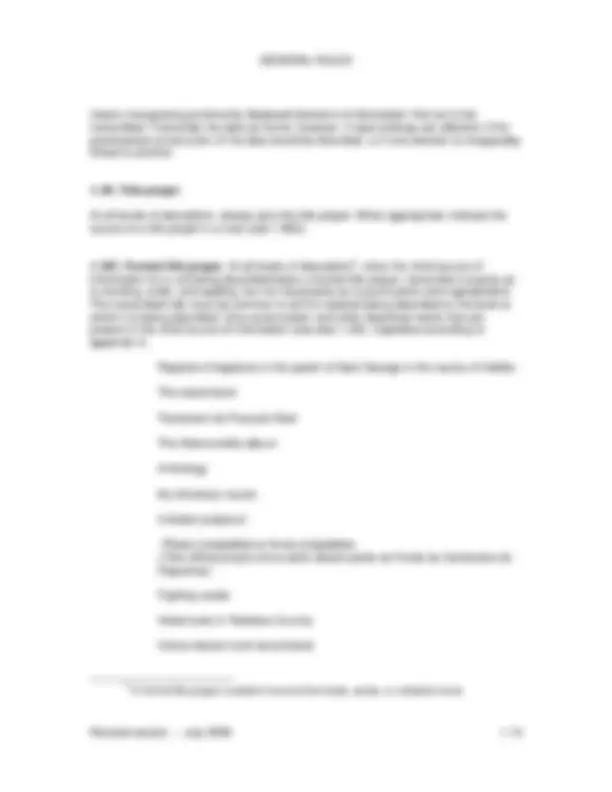
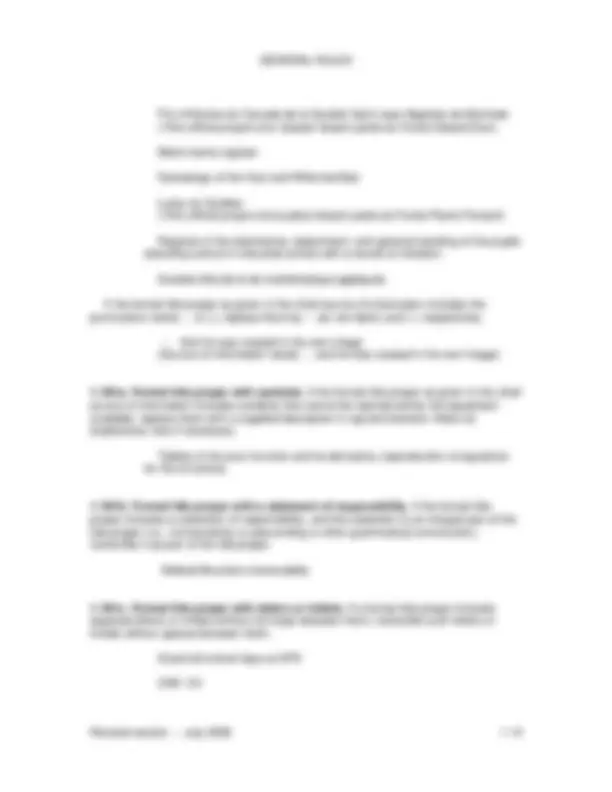
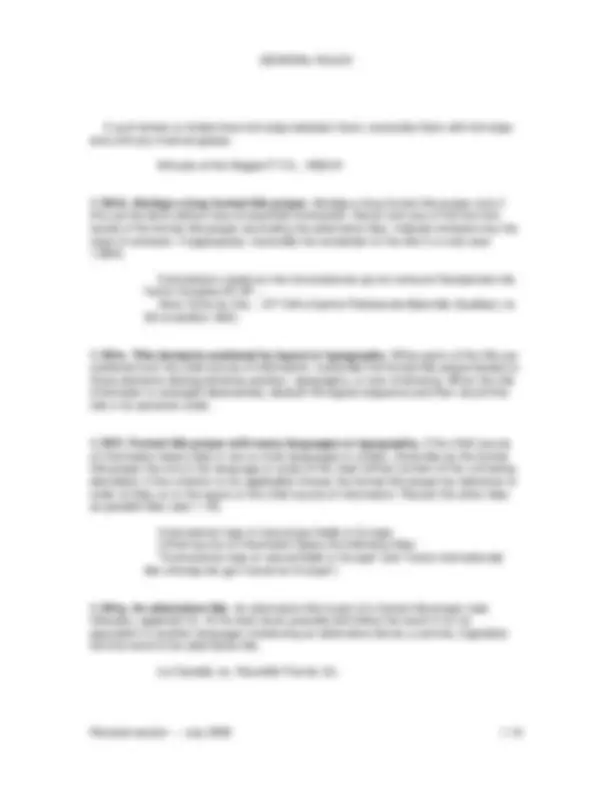
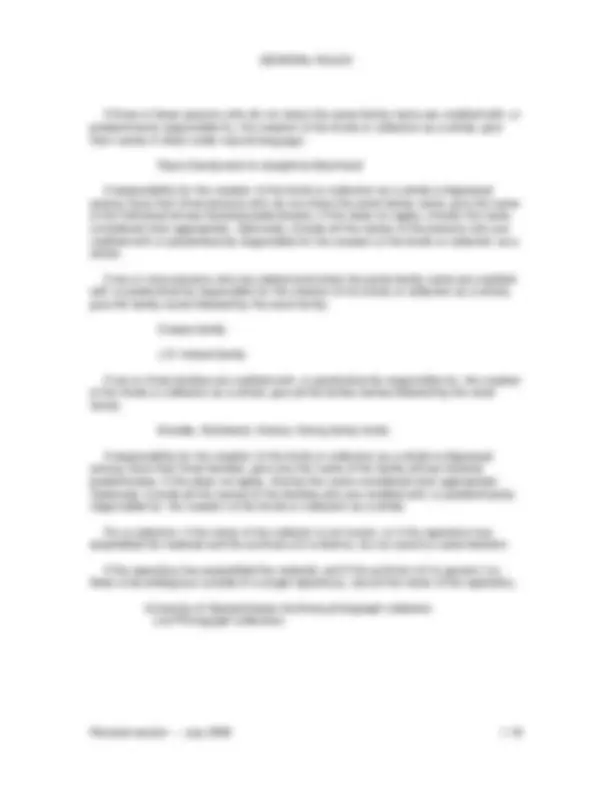
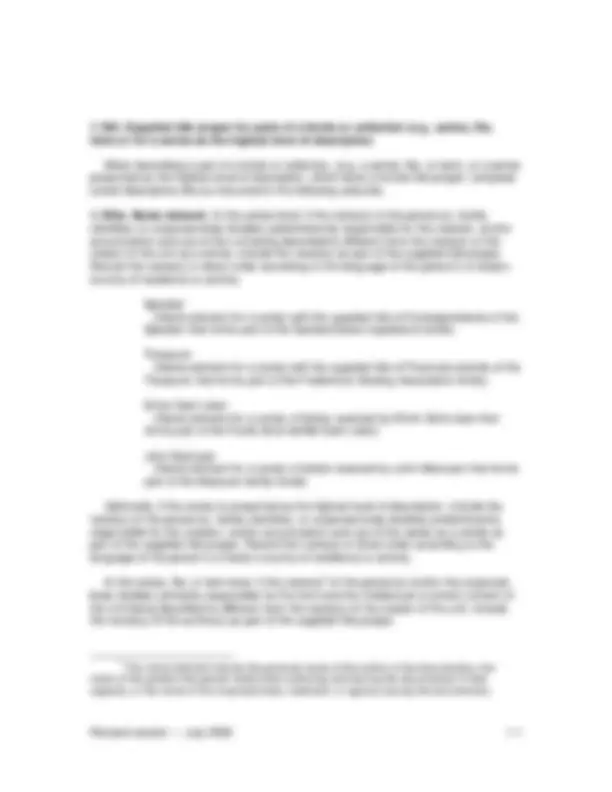
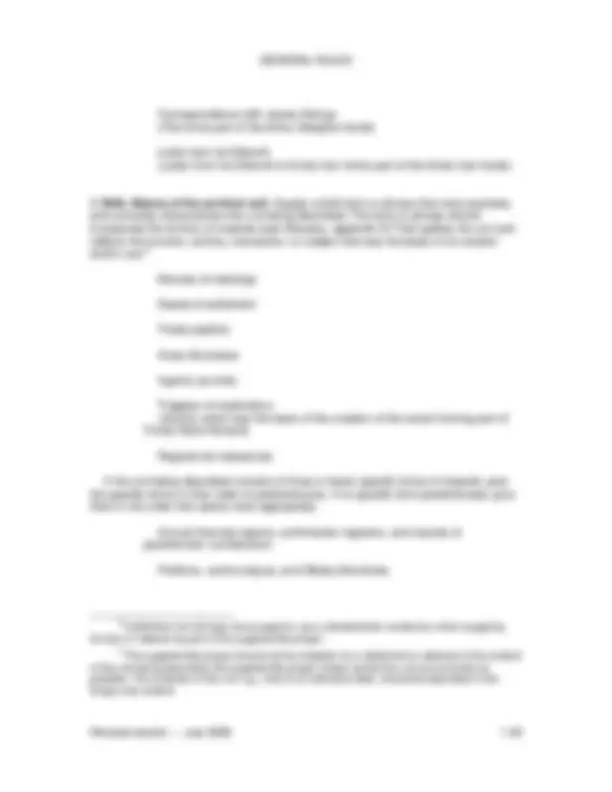
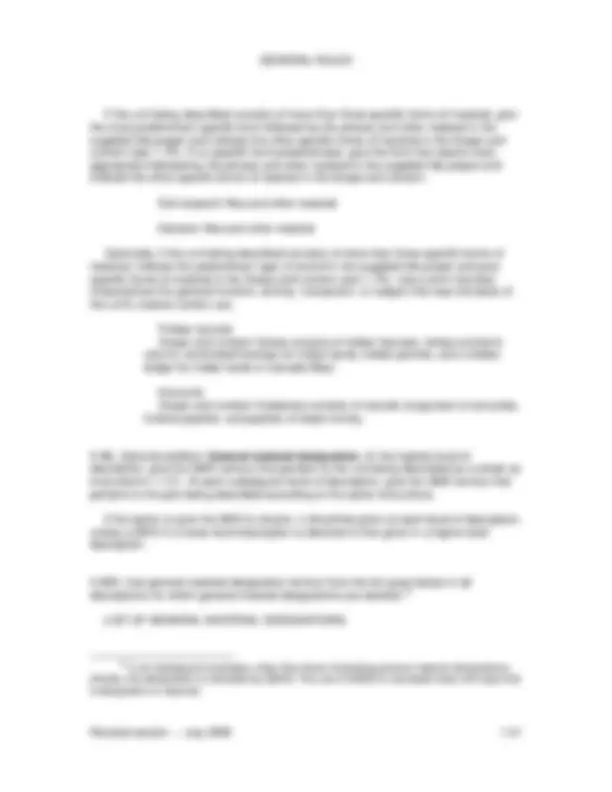
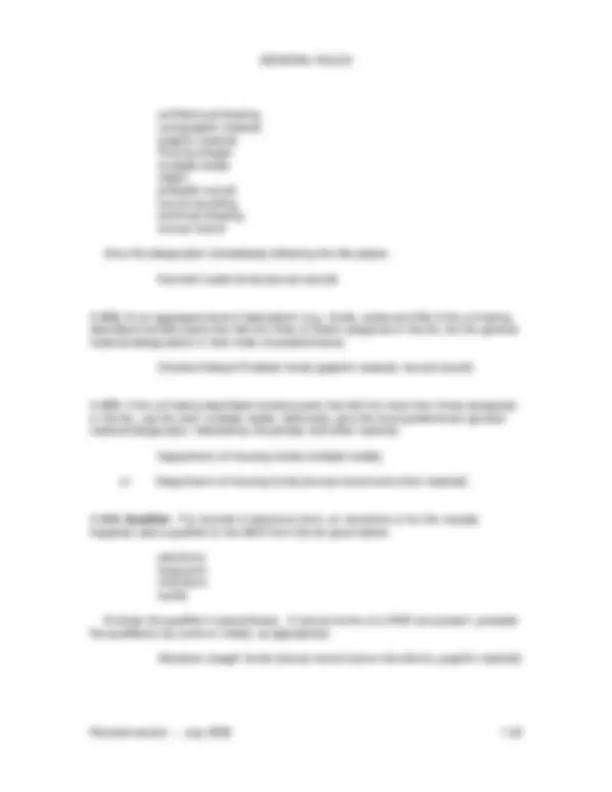
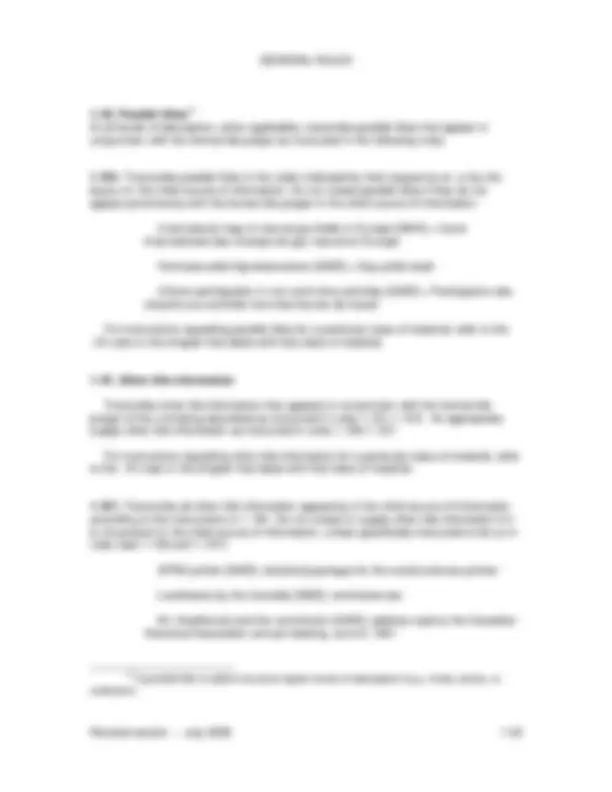
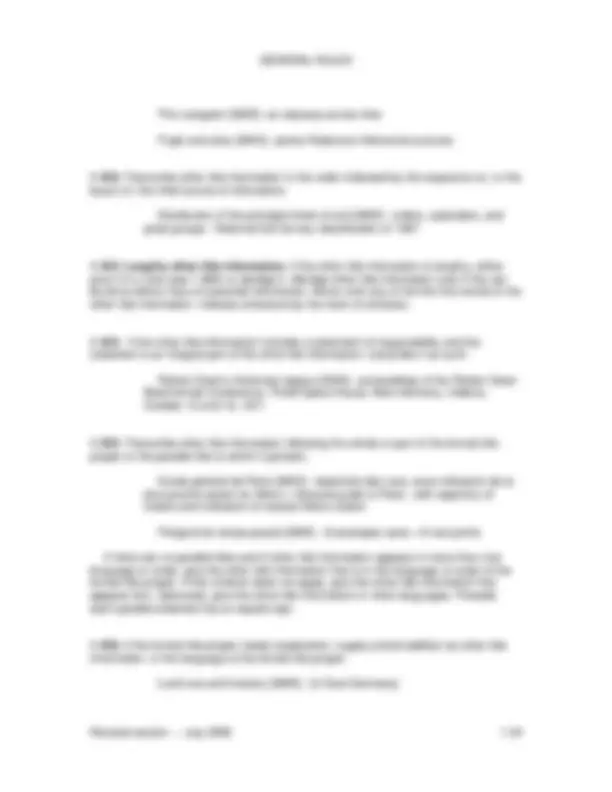
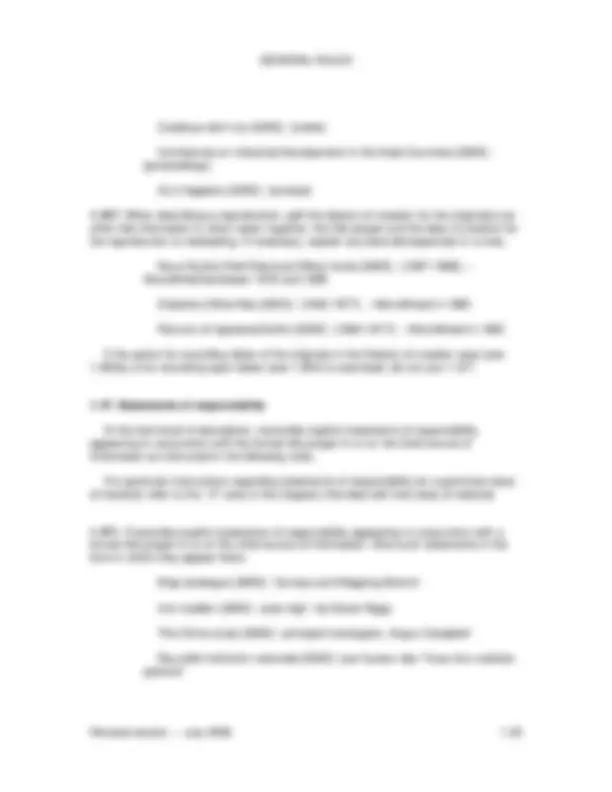
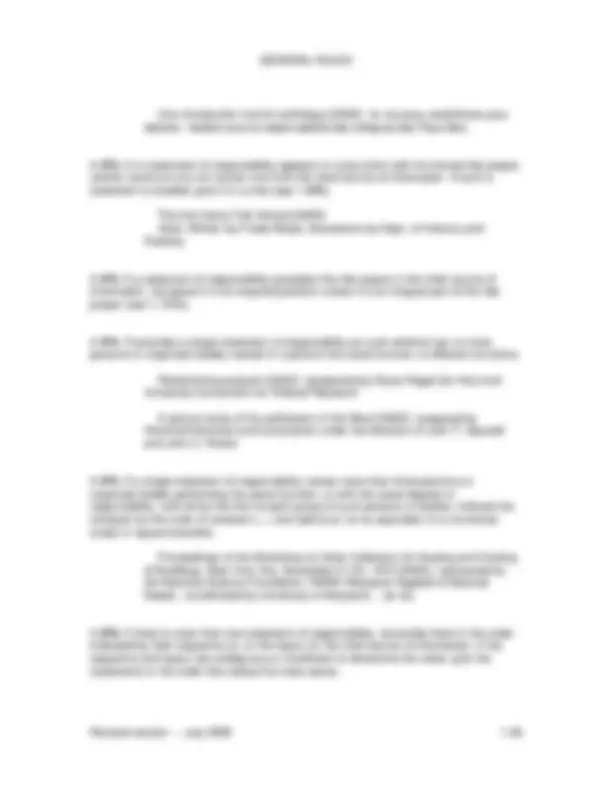
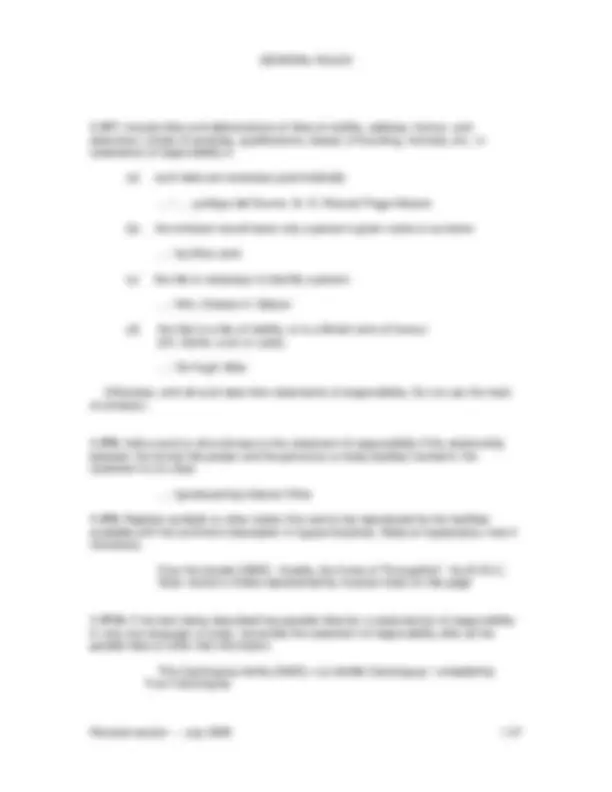
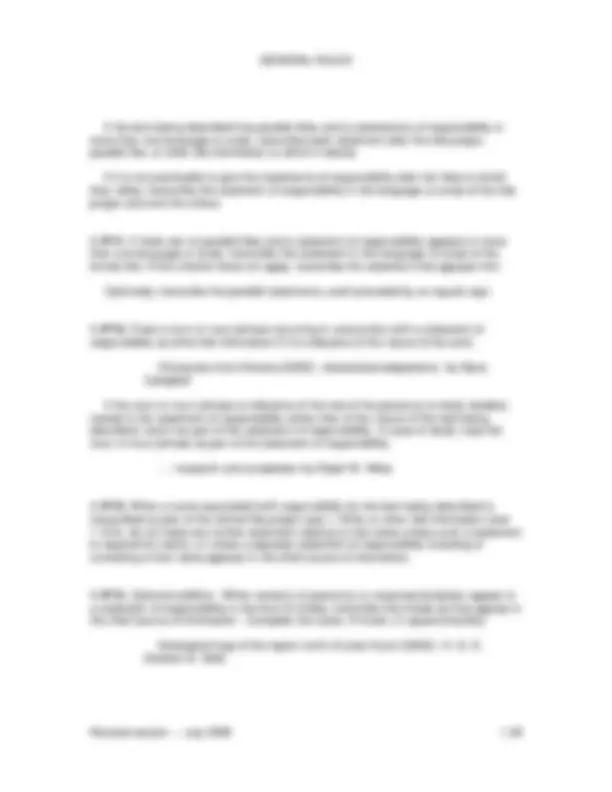
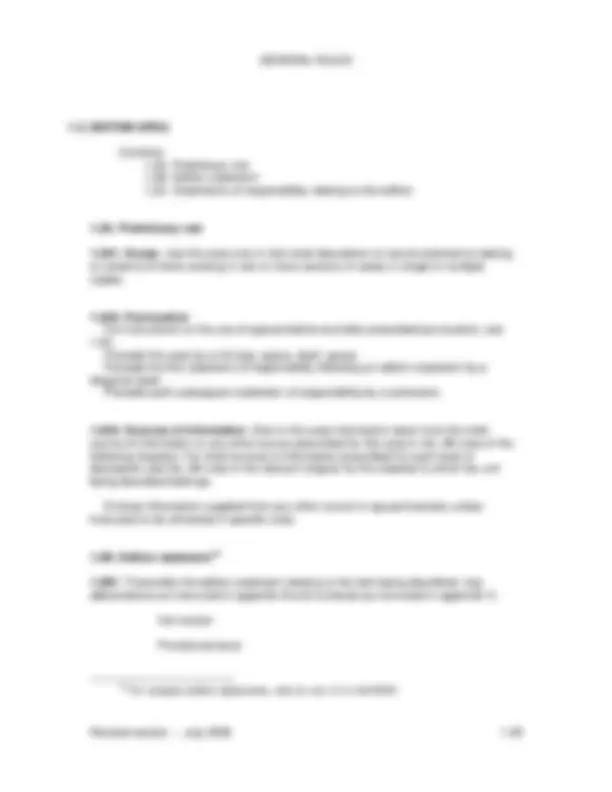
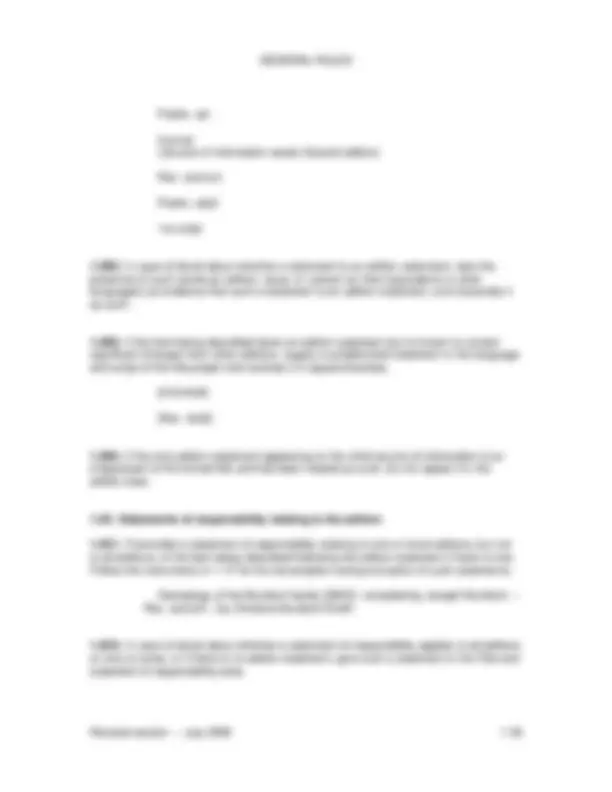
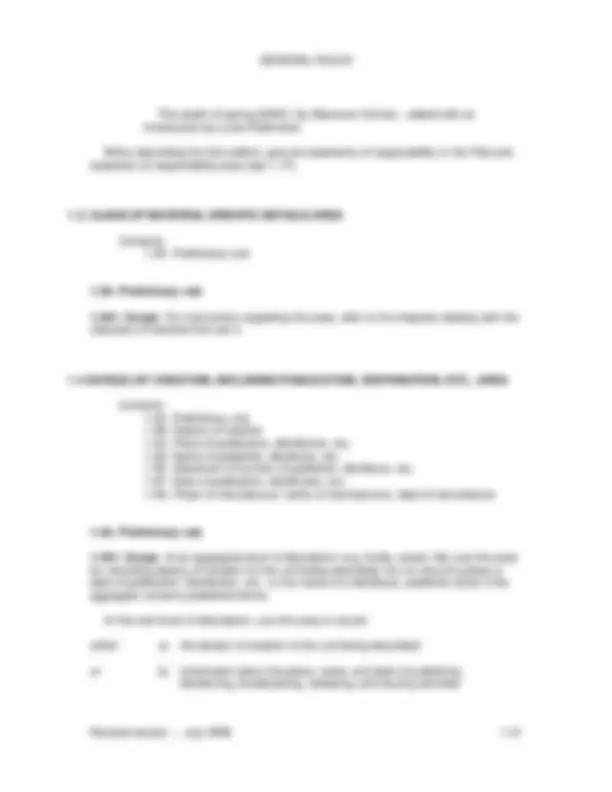
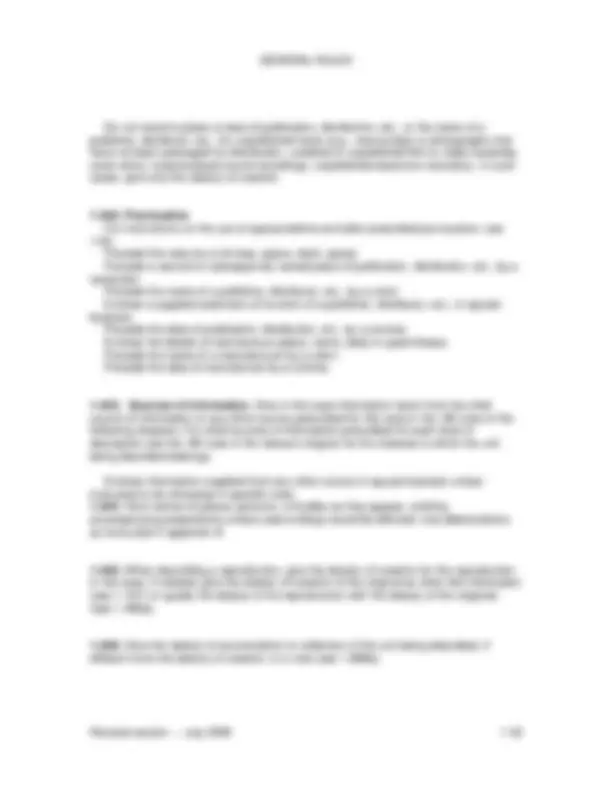
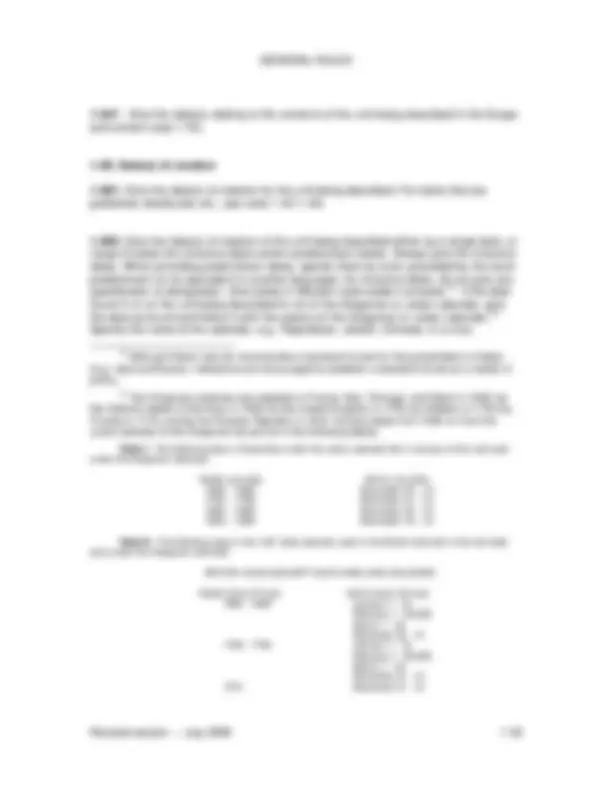
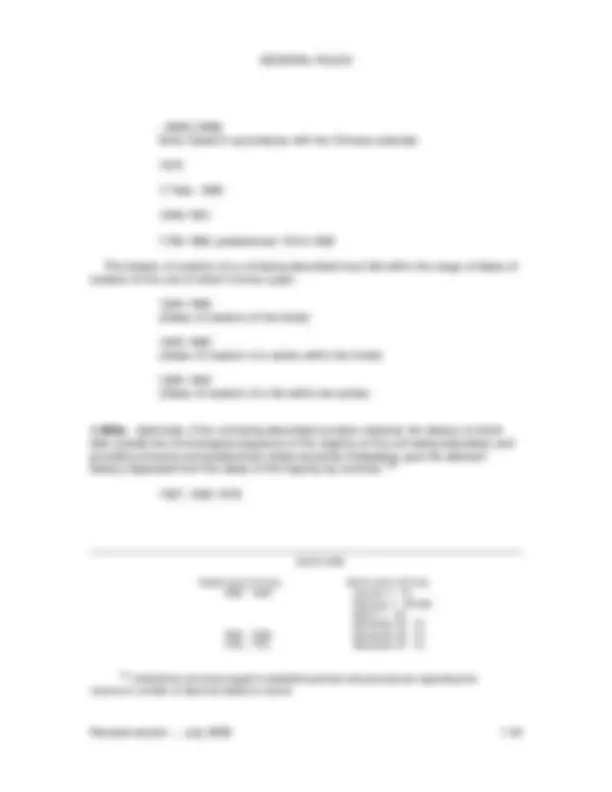
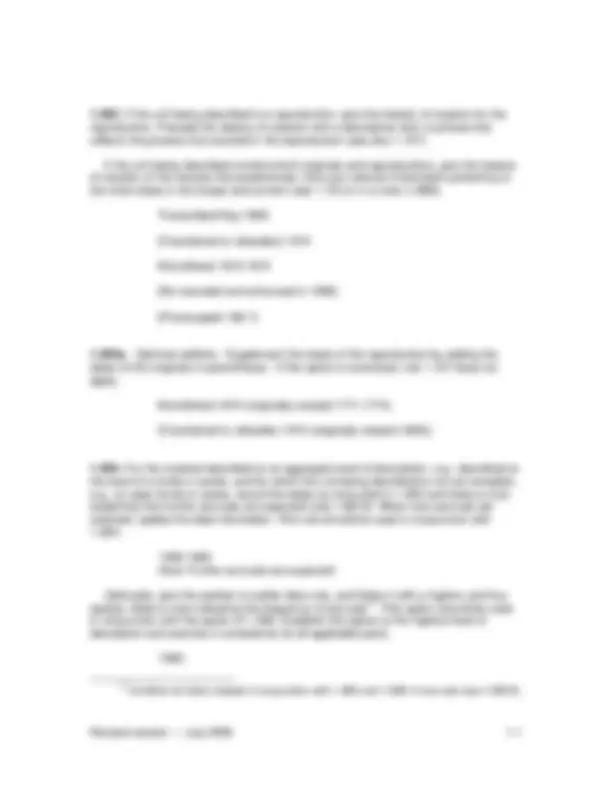
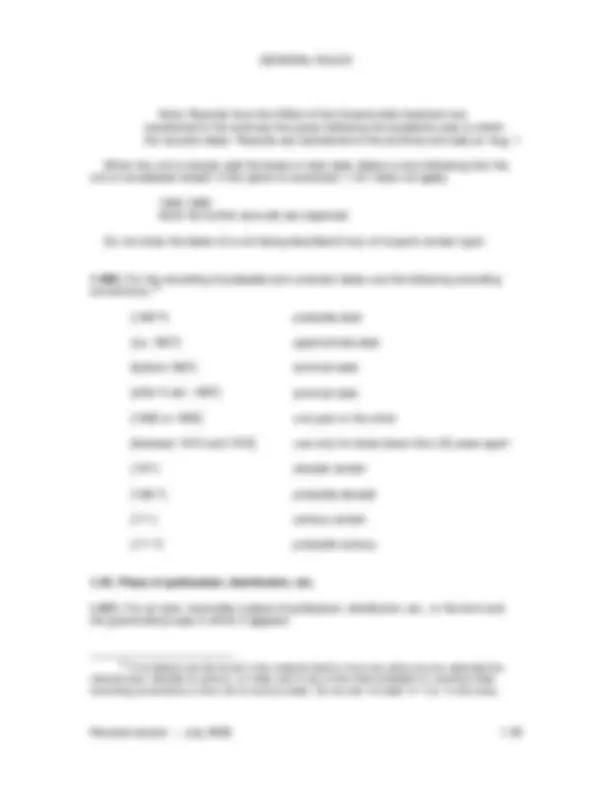
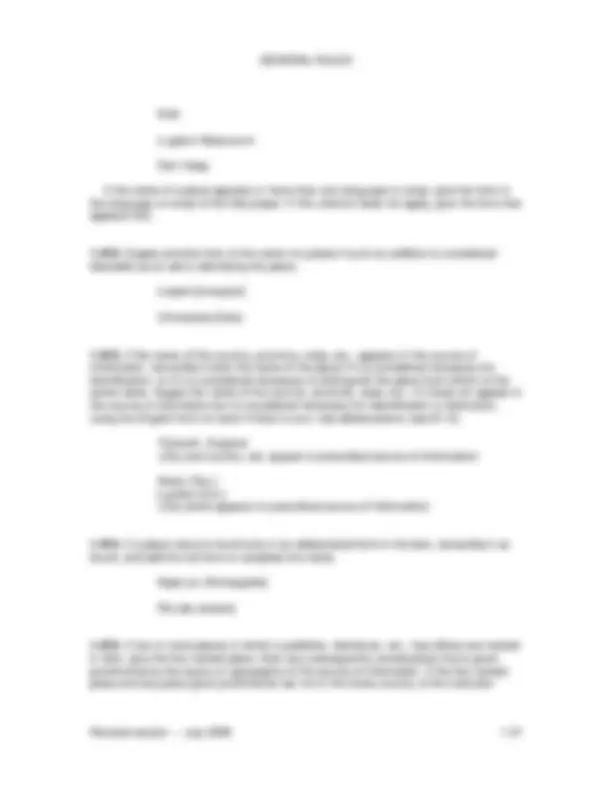
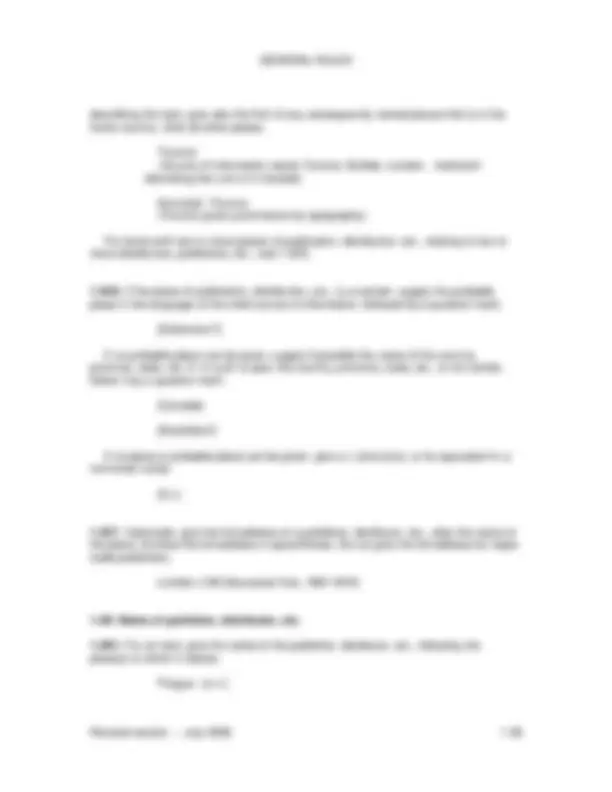
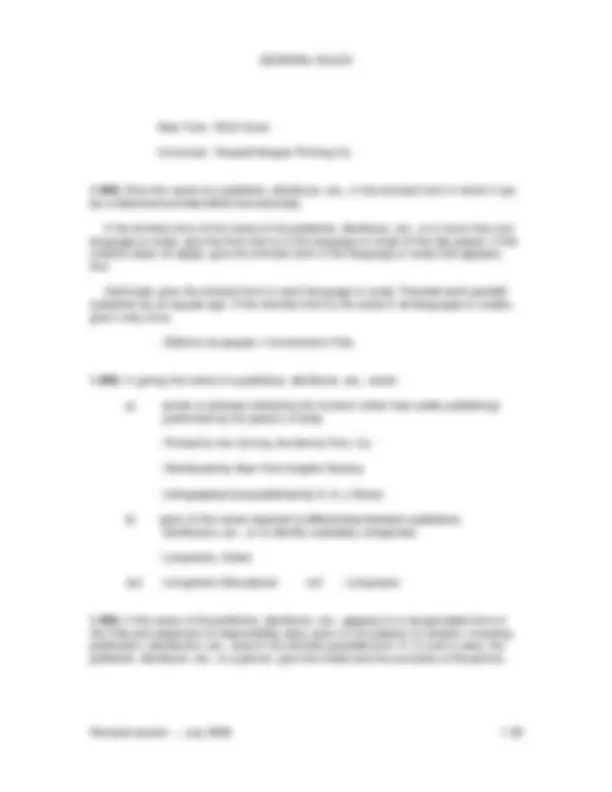
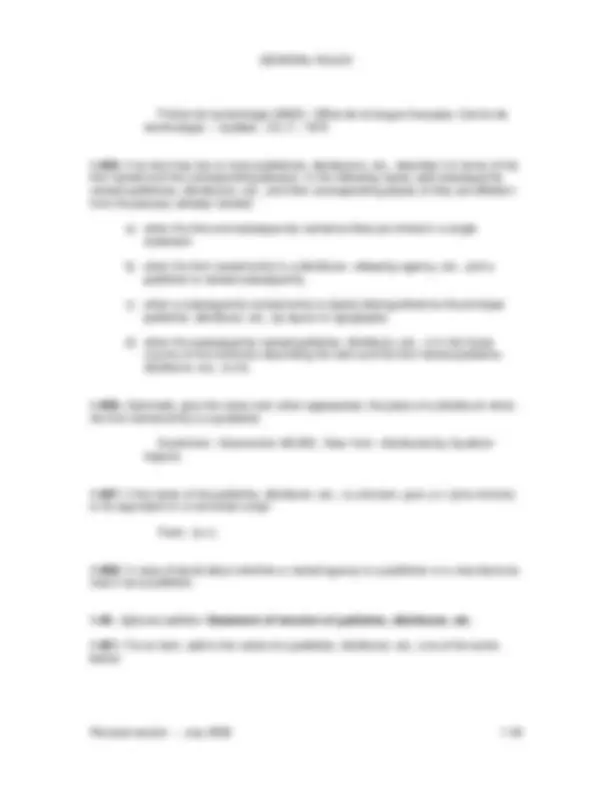
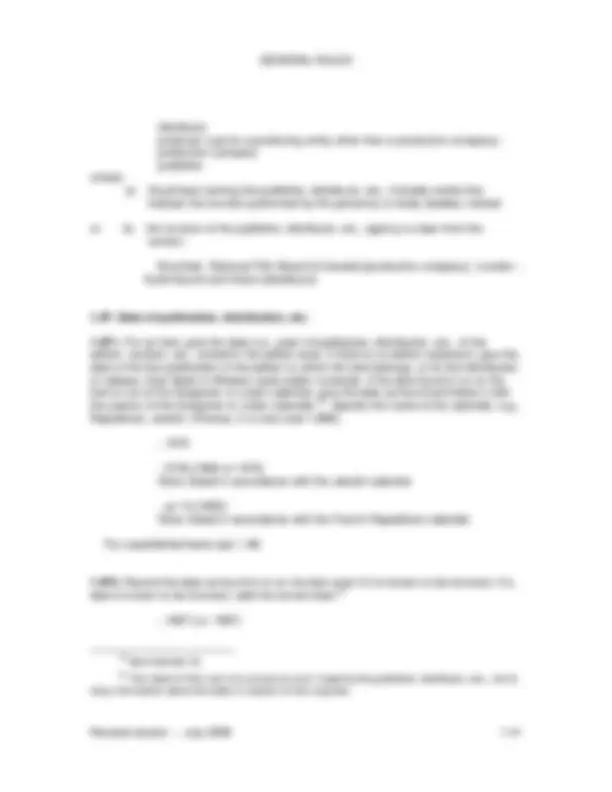
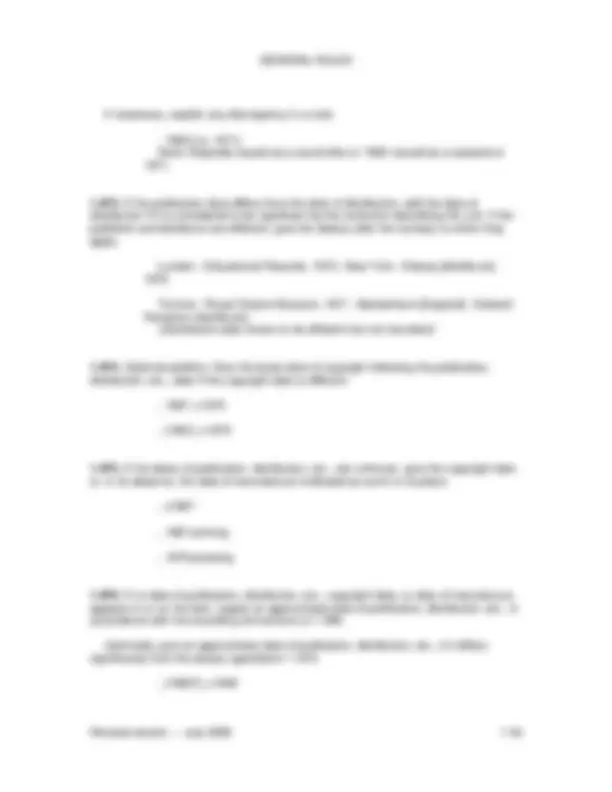
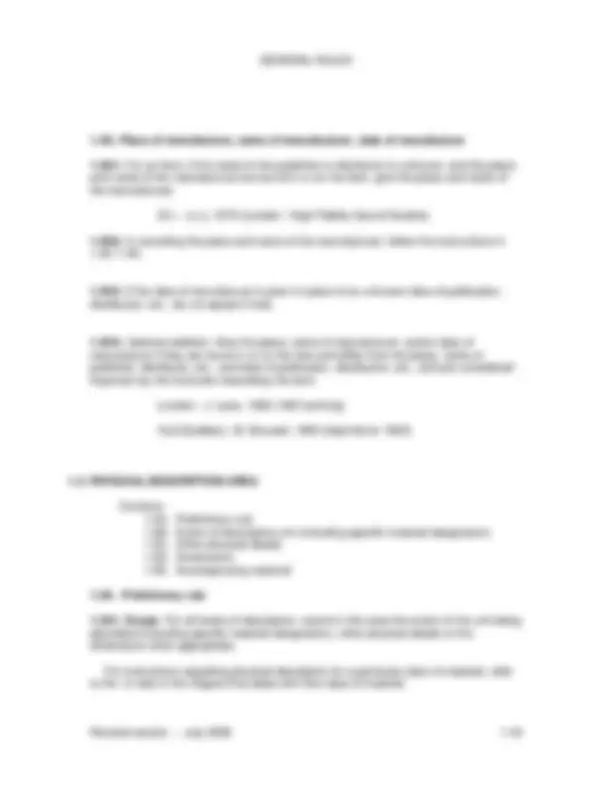
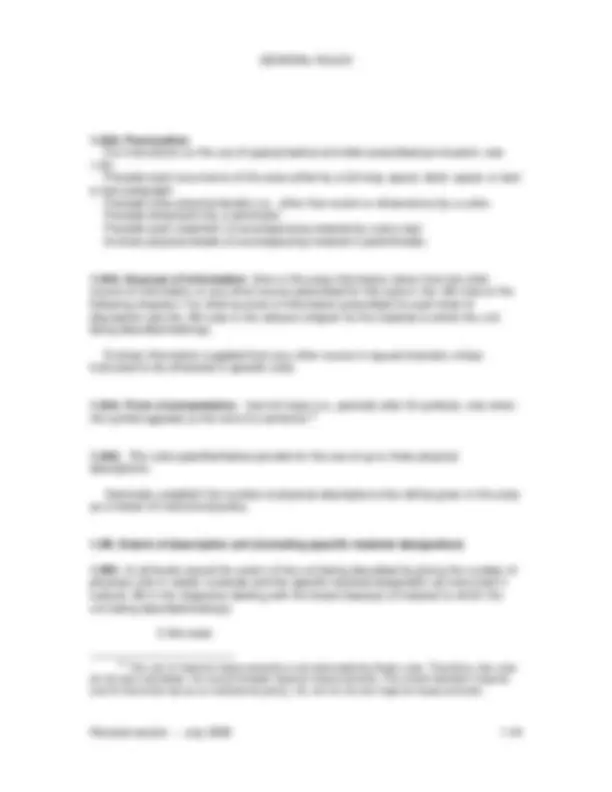
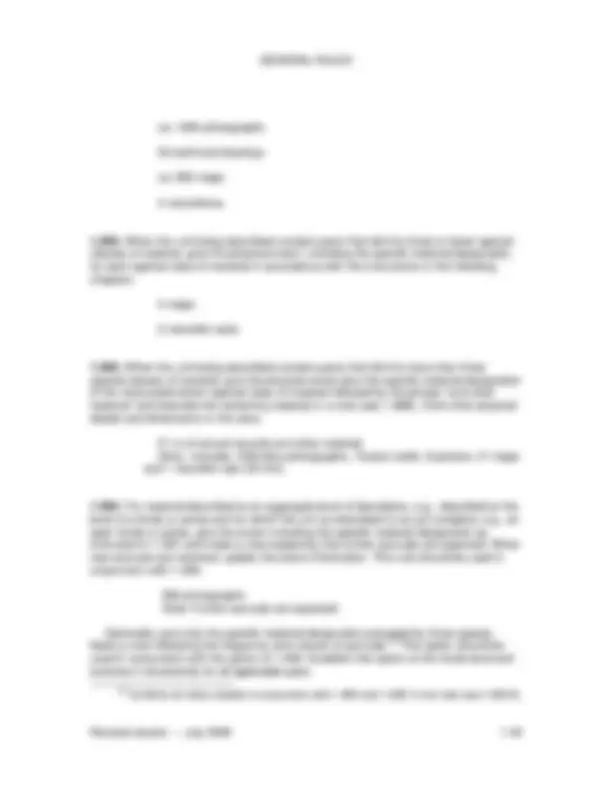
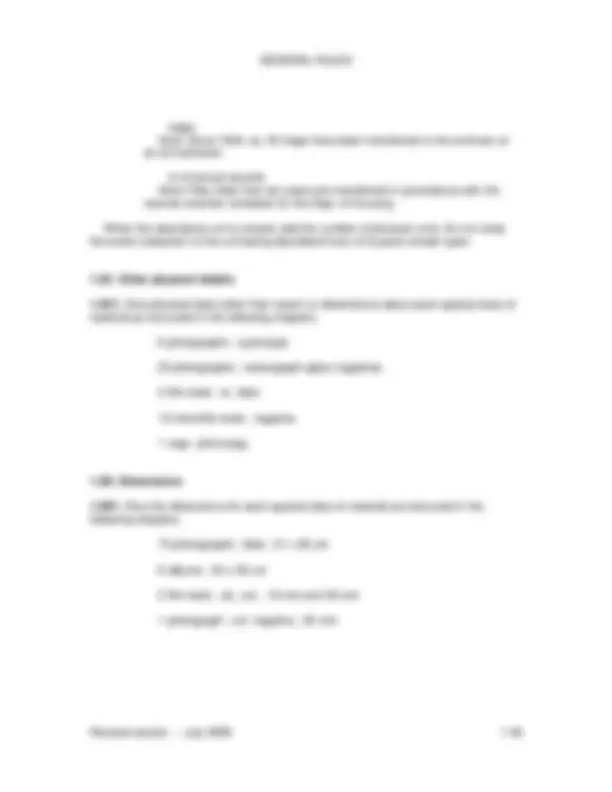
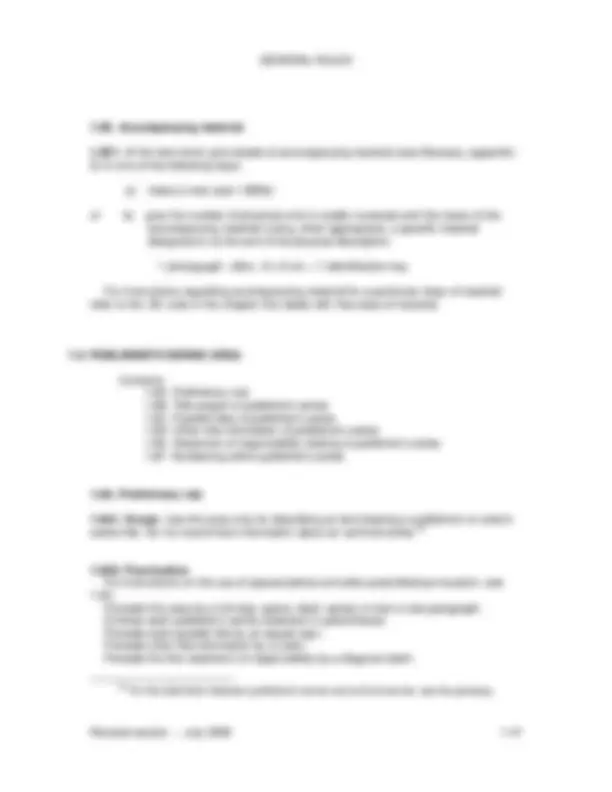
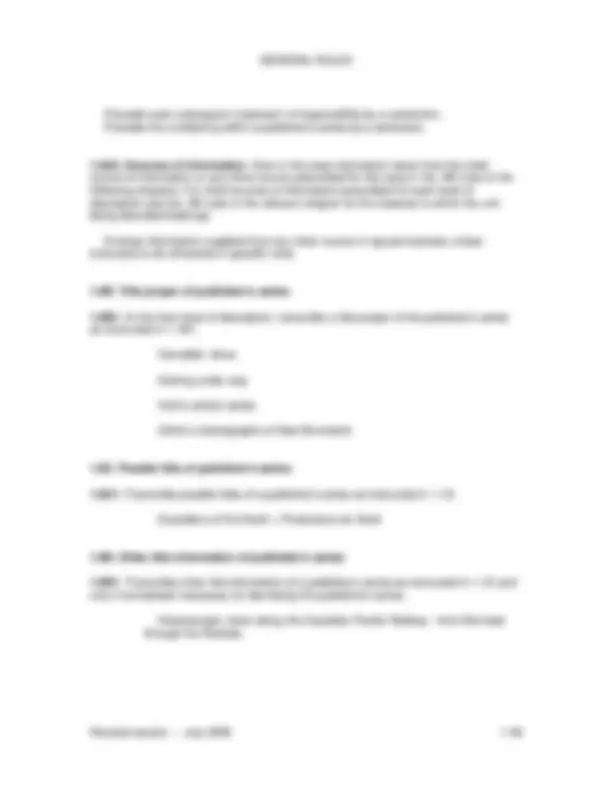
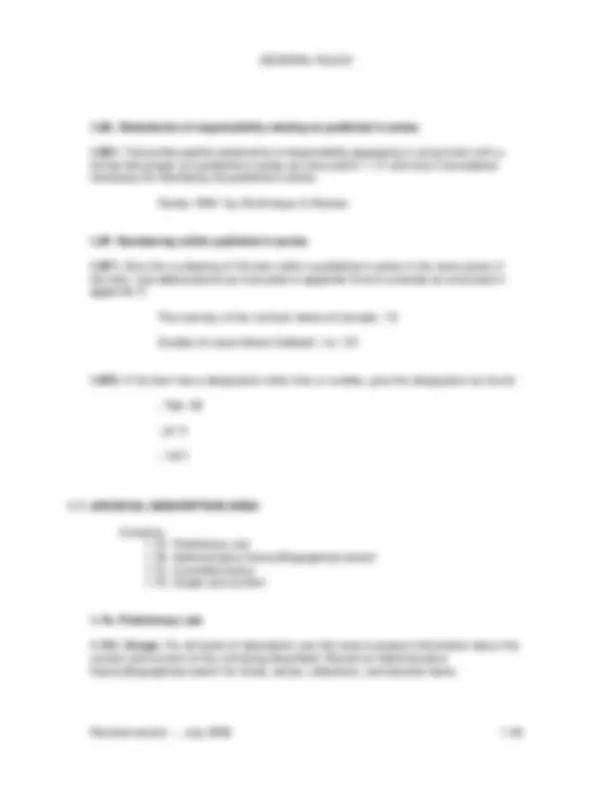
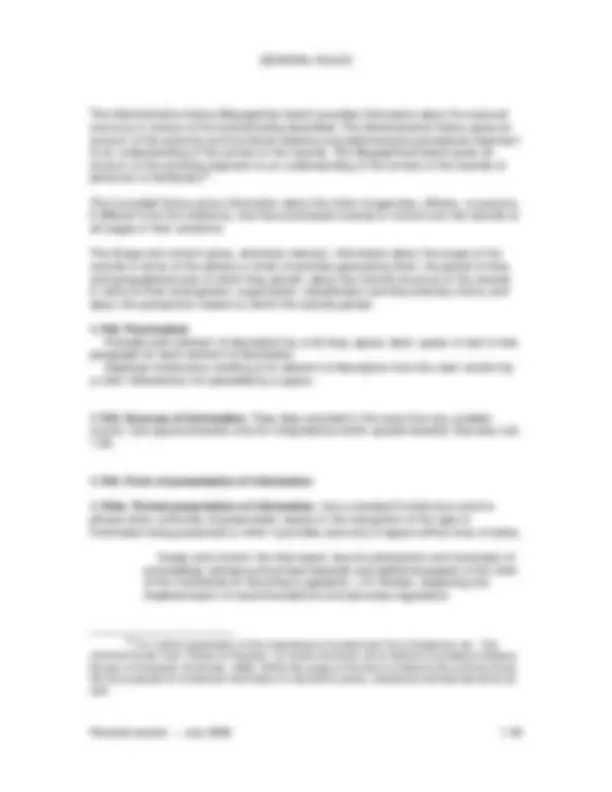
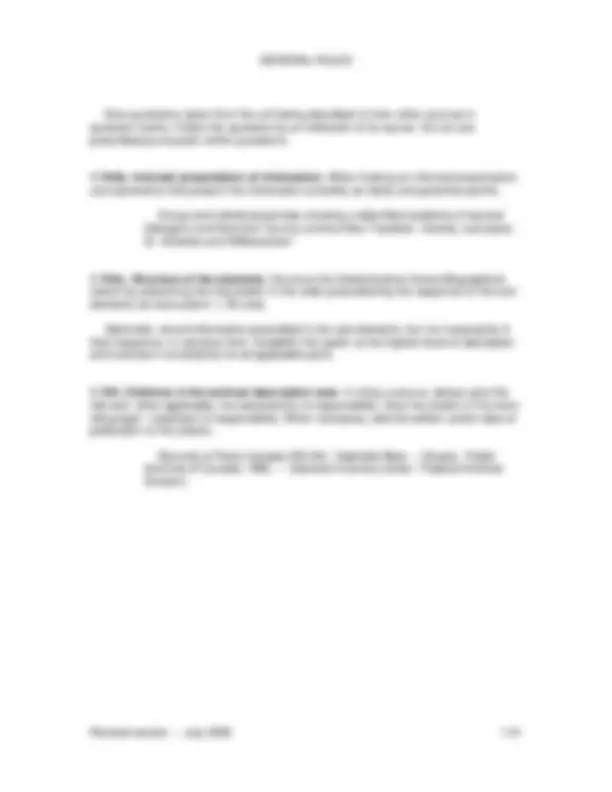
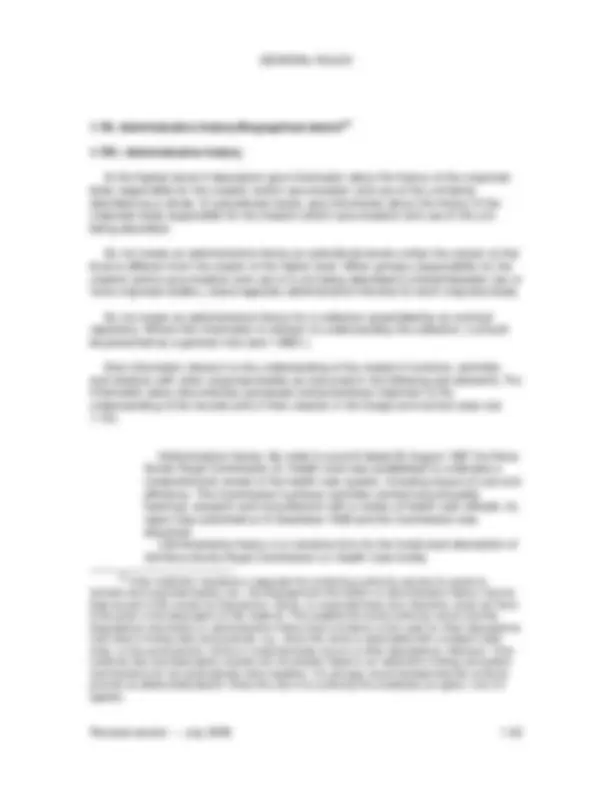
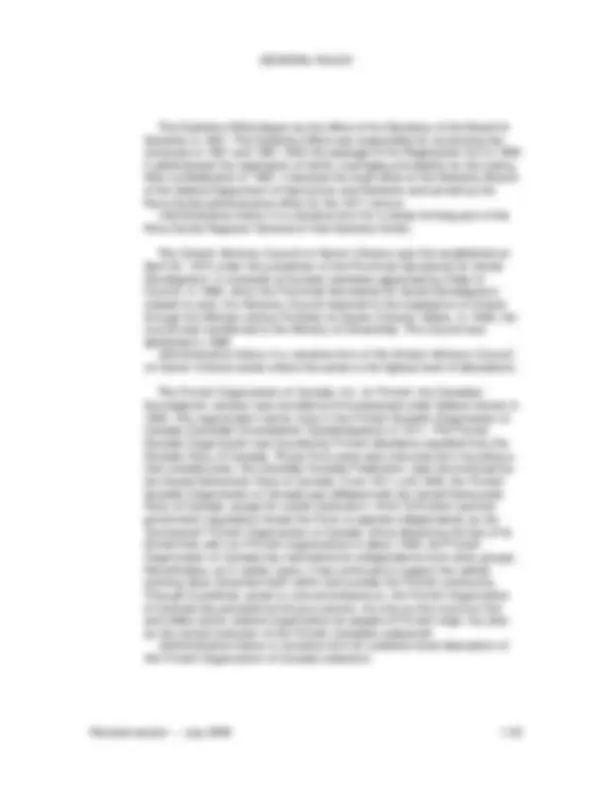
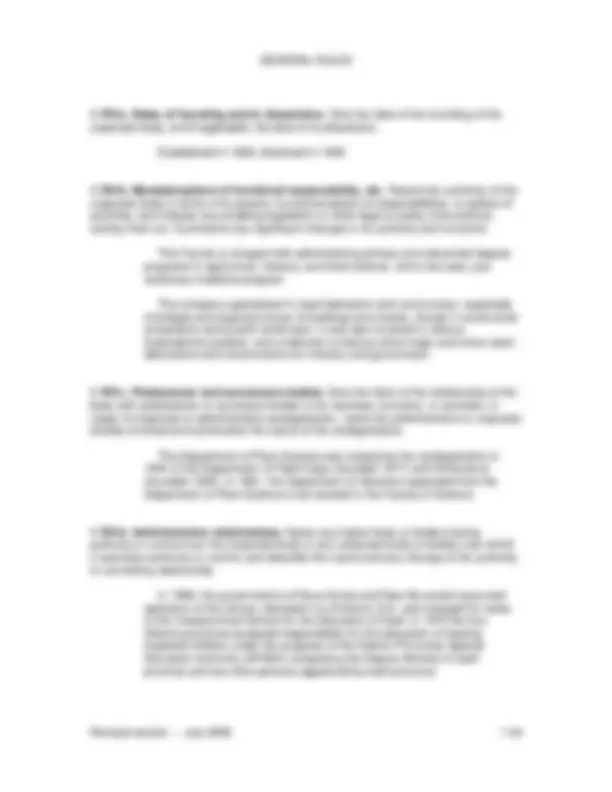
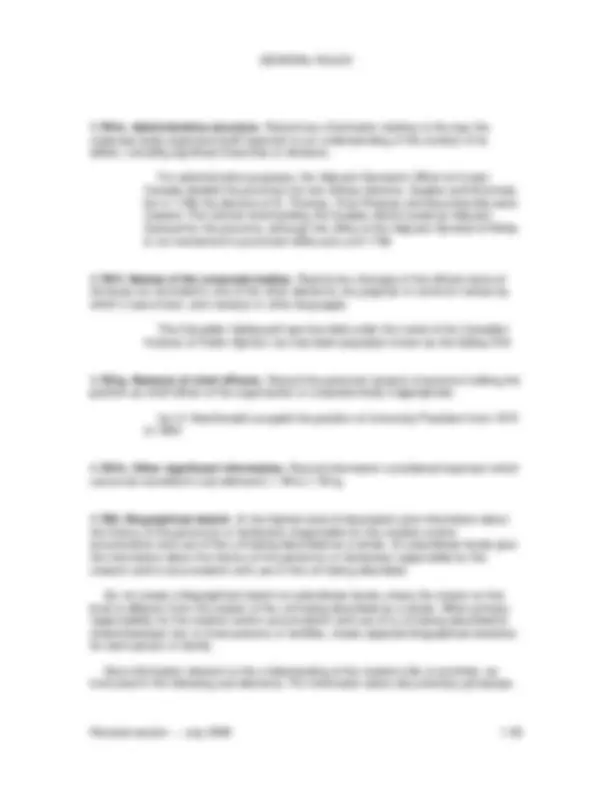
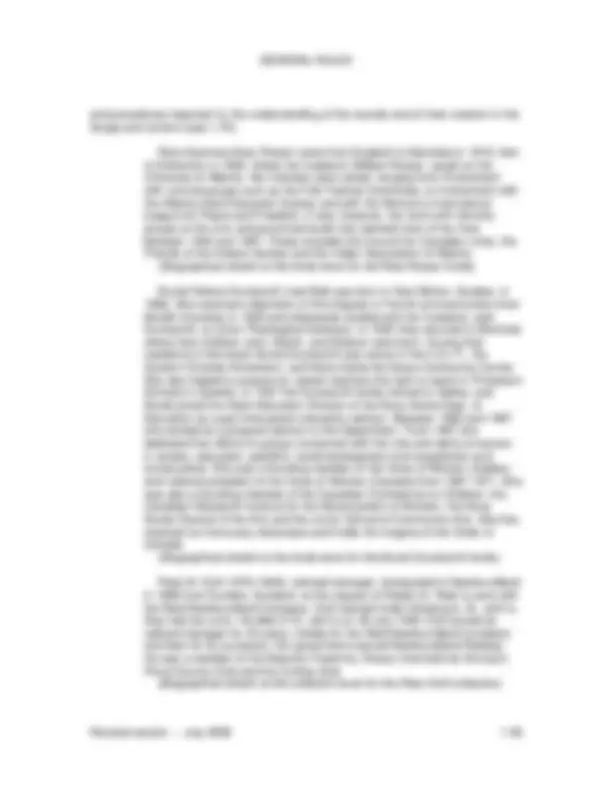
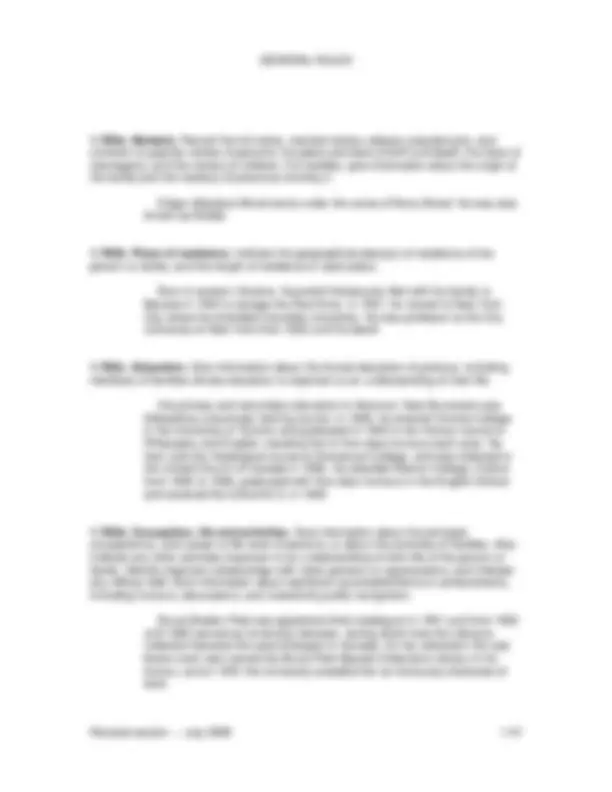
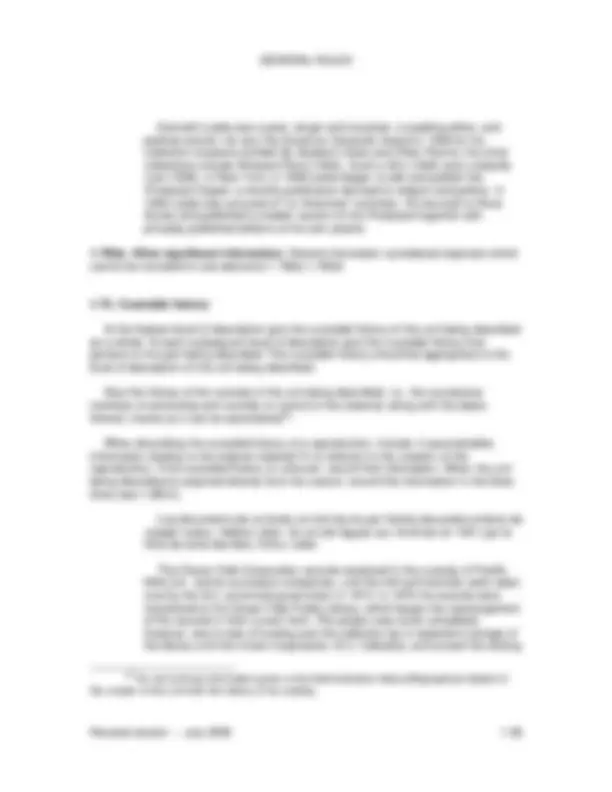
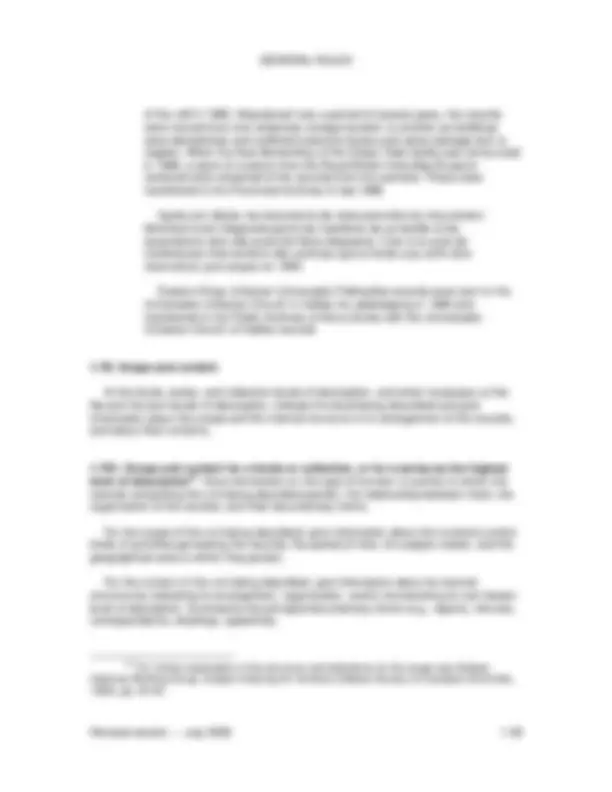
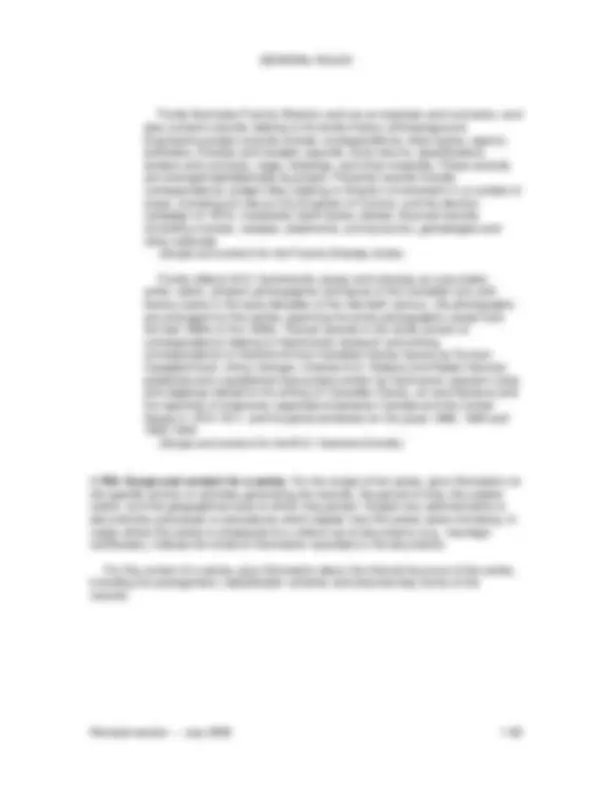
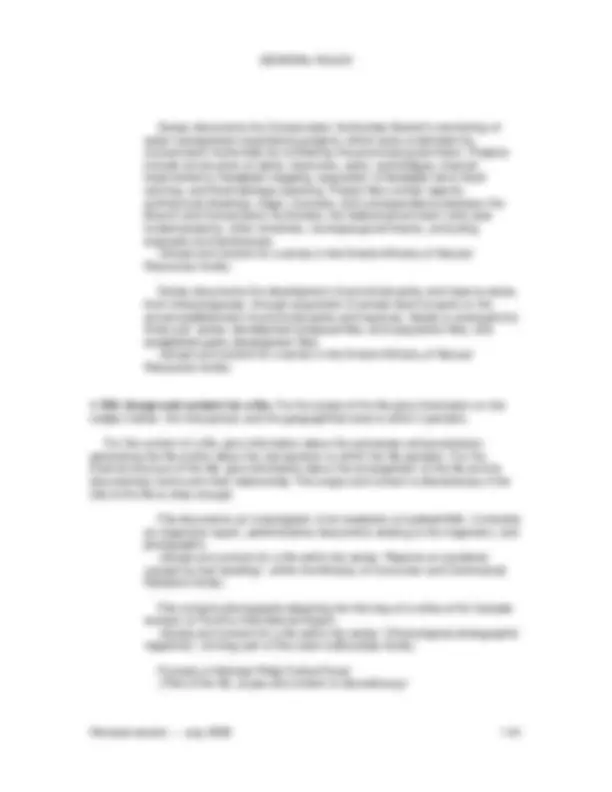
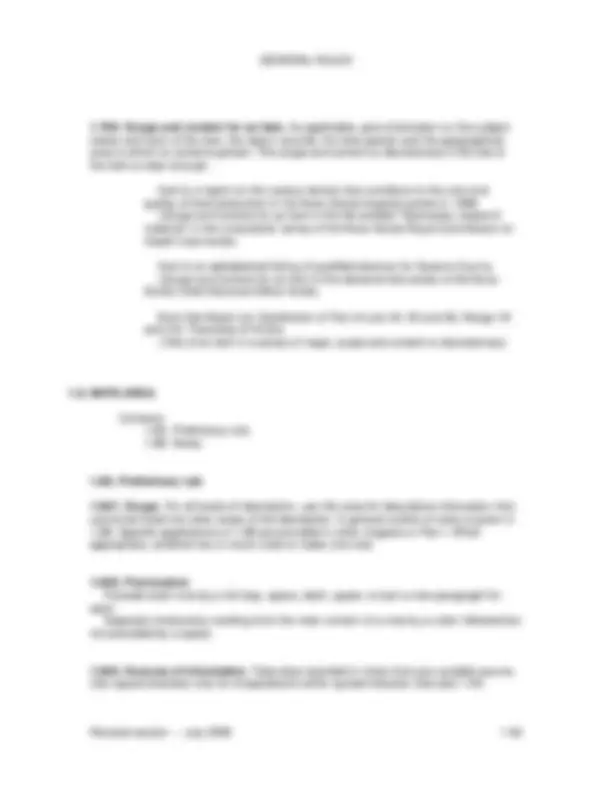
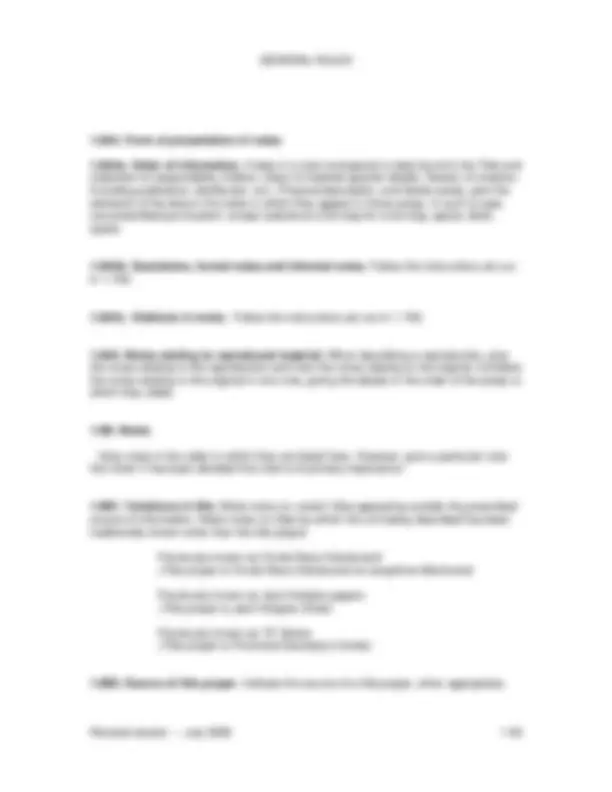
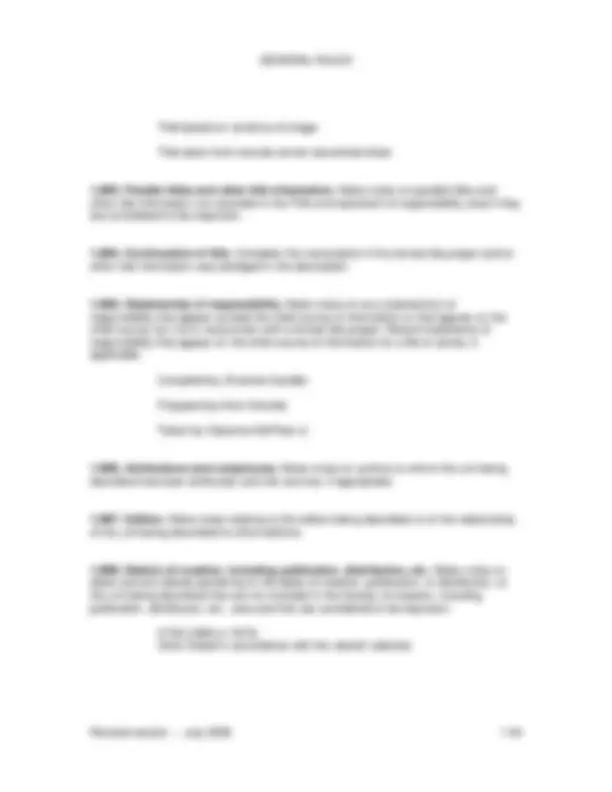
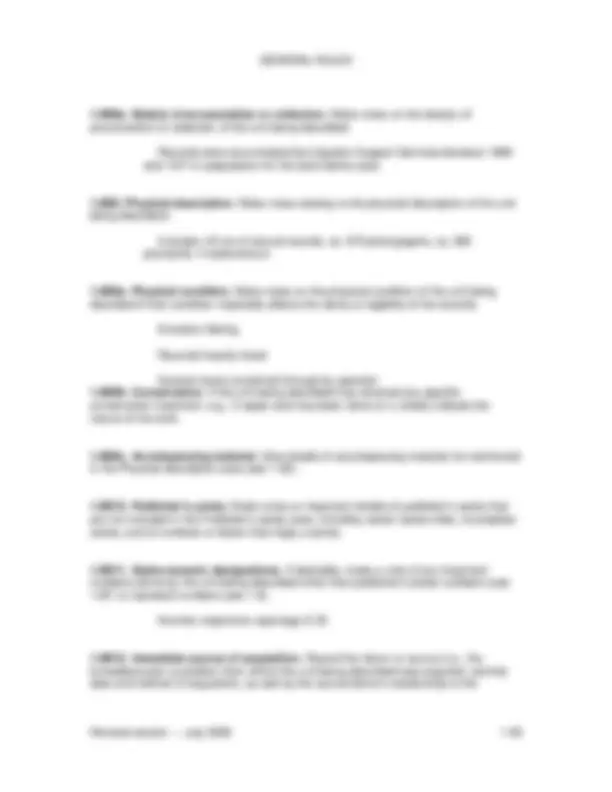
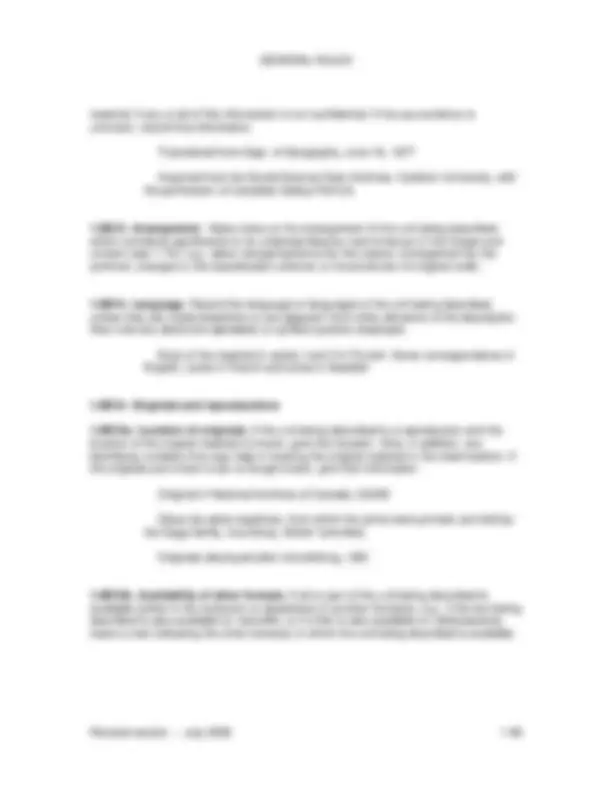
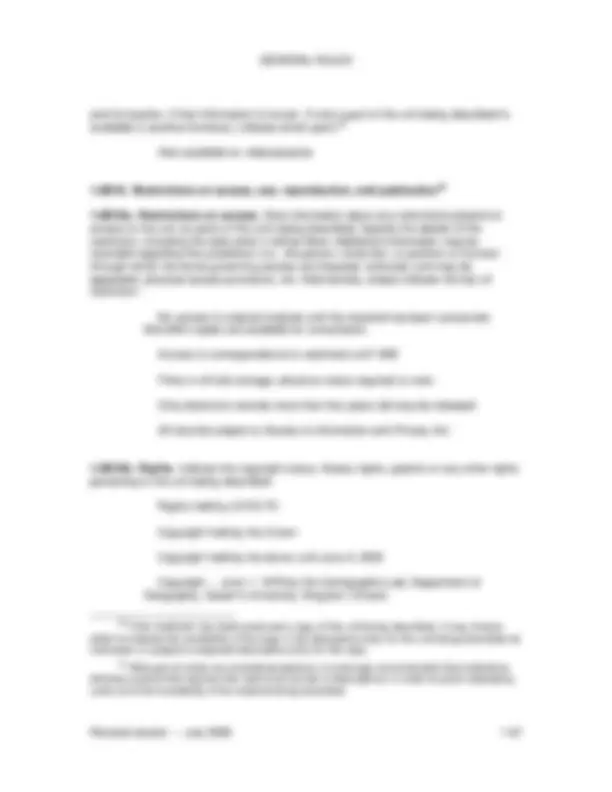
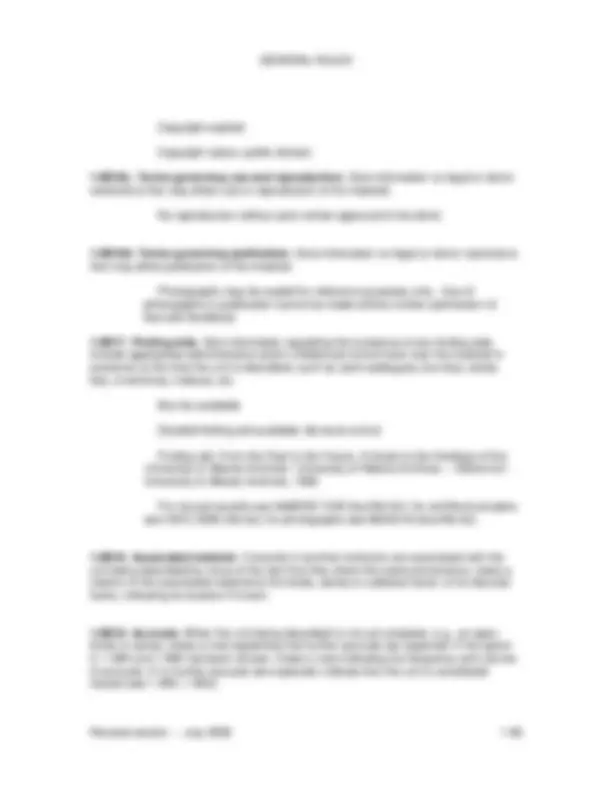
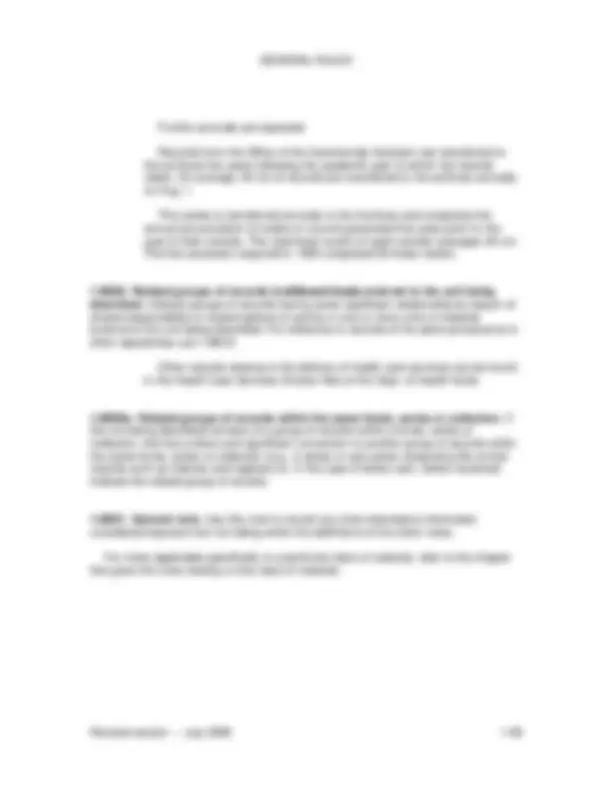
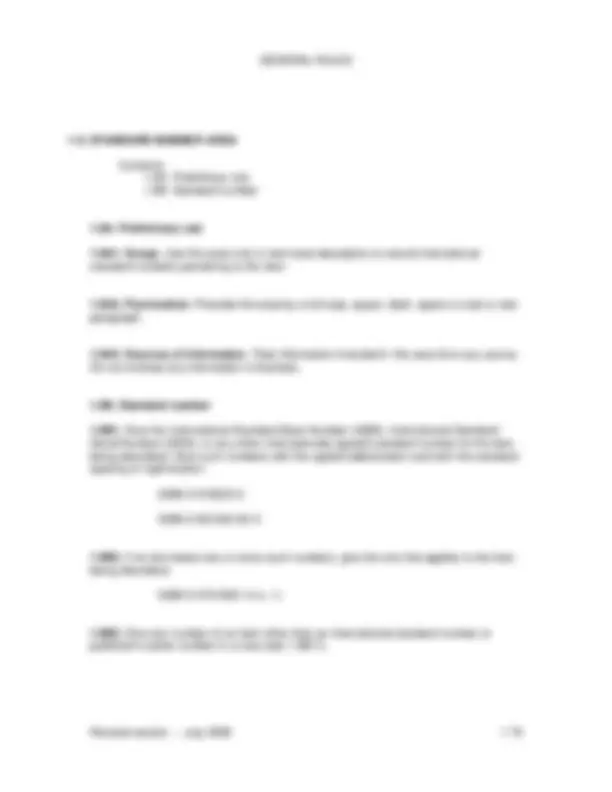


Study with the several resources on Docsity

Earn points by helping other students or get them with a premium plan


Prepare for your exams
Study with the several resources on Docsity

Earn points to download
Earn points by helping other students or get them with a premium plan
Community
Ask the community for help and clear up your study doubts
Discover the best universities in your country according to Docsity users
Free resources
Download our free guides on studying techniques, anxiety management strategies, and thesis advice from Docsity tutors
RAD_Chapter 1 Cataloging and classification
Typology: Lecture notes
1 / 70

This page cannot be seen from the preview
Don't miss anything!































































1.0A Preliminary rule 1.0A1 Scope 1.0A2 Multilevel description 1.0A3 Sources of information 1.0A4 Form of presentation 1.0B Organization of the description 1.0C Punctuation 1.0D Levels of detail in the description 1.0E Language and script of the description 1.0F Inaccuracies 1.0G Accents and other diacritical marks
1.1A Preliminary rule 1.1B Title proper 1.1C General material designation 1.1D Parallel titles 1.1E Other title information 1.1F Statements of responsibility
1.2A Preliminary rule 1.2B Edition statement 1.2C Statements of responsibility relating to the edition
1.3A Preliminary rule
1.4A Preliminary rule 1.4B Date(s) of creation 1.4C Place of publication, distribution, etc. 1.4D Name of publisher, distributor, etc. 1.4E Statement of function of publisher, distributor, etc. 1.4F Date of publication, distribution, etc. 1.4G Place of manufacture, name of manufacturer, date of manufacture
1.5A Preliminary rule 1.5B Extent of descriptive unit (including specific material designation) 1.5C Other physical details 1.5D Dimensions 1.5E Accompanying material
1.6A Preliminary rule 1.6B Title proper of publisher's series 1.6C Parallel titles of publisher's series 1.6D Other title information of publisher's series 1.6E Statement of responsibility relating to publisher's series 1.6F Numbering within publisher's series
1.7A Preliminary rule 1.7B Administrative history/Biographical sketch 1.7C Custodial history 1.7D Scope and content
1.0A. Preliminary rule
1.0A1. Scope. These rules may be used to describe fonds, series, collections, and discrete items.
Where the description of a fonds, series, or collection as a whole constitutes the highest level of description, the descriptions of its parts constitute lower levels of description. Using these rules, archival materials are represented by a set of descriptions which show the unit as a dynamic whole, consisting of lower-level parts that may include series, files, and items. Each of these parts becomes (or has the potential to become) an object of description, resulting in multiple descriptions that need to be linked hierarchically to represent the part-to-whole structure.^1
Institutions also acquire discrete items that do not form part of a larger body of materials (e.g., a fonds). These rules also provide guidance for the consistent description of and access to discrete items, alongside other holdings. For the description of discrete items, refer to the rules contained in Chapter 13.
For the level of detail required at different levels of description see 1.0D.
1.0A2. Multilevel description. Use multilevel description for preparing descriptions of archival material whose arrangement is characterized by multiple aggregations, and when, in addition to the highest level of description, separate descriptions of some or all of its parts are required.
The following rules apply when establishing a hierarchy of descriptions.
1.0A2a. Description from the general to the specific. At the highest level of description, give information for the fonds, series or collection as a whole. At the next and subsequent levels, give information for the parts being described. Present the resulting descriptions in a hierarchical part-to-whole relationship proceeding from the highest level to the more specific.
(^1) The rules in this chapter do not prescribe the number of levels to be described in a multilevel description. The decision to describe to a certain level is an institutional one that will vary from one unit of material to the next, depending on the nature, size, and importance of the various component parts. Nor do the rules require that, at a given level of description (e.g., at the file level), all the records at that level (e.g., all of the file) be described.
1.0A2b. Information relevant to the level of description. Provide only such information that is appropriate to the level being described. For example, do not provide detailed file content information if the unit being described is a fonds; do not provide an Administrative history for an entire department if the creator of a unit being described is a division or a branch.
1.0A2c. Linking of descriptions. Link each description to its next higher unit of description, if applicable, and identify the level of description in the Scope and content (see 1.7D).
1.0A2d. Non-repetition of information. At the highest appropriate level, give information that is common to the component parts. Do not repeat information at a lower level of description that has already been given at a higher level, unless specifically instructed to do so in the following rules, or unless essential for clarity. 1a
1.0A3. Sources of information. Each chapter in Part I contains a specification of the chief source of information for each level of description at which the material is being described within the broad class of material covered by that chapter.
For each area of the description one or more sources of information are prescribed. Enclose in square brackets information taken from outside the prescribed source(s) unless otherwise instructed in specific rules.
For an aggregate level of description (e.g., for a fonds, series, file) the chief source of information will be collective in nature.
For an item, the chief source of information may be collective or may be unitary in nature. An example of a chief source of information that is unitary in nature is the chief source for a textual item which is the title page.
Prefer information found in that chief source to information found elsewhere. When the sources of information are placed in a ranking order, follow that order.
1.0A4. Form of presentation. Make the levels of description distinct by layout or typography.
1a (^) Institutions may, as a matter of policy, decide to repeat information at each level of
description regardless of whether it is given at a higher level.
Precede the first element of each area, other than the first element of the first area or the first element of an area beginning a new paragraph, by a full stop, space, dash, space. When that element is not present in a description, precede the first element that is present by a full stop, space, dash, space instead of the prescribed preceding punctuation for that element.
Indicate an interpolation (i.e., data taken from outside the prescribed source(s) of information) by enclosing it in square brackets. Indicate a conjectural interpolation by adding a question mark within the square brackets. Indicate the omission of part of an element by the mark of omission (...). Precede and follow the mark of omission by a space. Omit any area or element that does not apply in describing a particular descriptive unit; also omit its prescribed preceding or enclosing punctuation. Do not indicate the omission of an area or element by the mark of omission.
When adjacent elements within one area are to be enclosed in square brackets, enclose them in one set of square brackets unless one of the elements is a general material designation, which is always enclosed in its own set of square brackets.
When adjacent elements are in different areas, enclose each element in a set of square brackets.
[2nd ed.]. – [London] : Thomsons, 1973
When an element ends with an abbreviation followed by a full stop or ends with the mark of omission and the punctuation following that element either is or begins with a full stop, omit the full stop that constitutes or begins the prescribed punctuation.
Warner Bros., Inc. – U.S. not Warner Bros., Inc.. – U.S.
When punctuation occurring within or at the end of an element is retained, give it with normal spacing. Prescribed punctuation is always added, even though double punctuation may result.
Quo vadis? : a narrative from the time of Nero
Spring has sprung! : a benefit evening
1.0C2. The following table specifies all elements for each area of description (see rule 1.0B) and illustrates the preceding prescribed punctuation as set out in rule 1.0C1. 2
(^2) This table (rule 1.0C2) is adapted from ISBD(G).
Area Prescribed preceding (or enclosing) punctuation for elements
Element
/ ;
1.1 Title proper 1.2 General material designation 1.3 Parallel title 1.4 Other title information 1.5 Statements of responsibility First statement Subsequent statement
2.1 Edition statement 2.2 Parallel edition statement 2.3 Statements of responsibility relating to the edition First statement Subsequent statement 2.4 Additional edition statement 2.5 Statement of responsibility following an edition statement First statement Subsequent statement
; :
[ ]
,
( : ,)
4.1 Dates of creation 4.2 Place of publication, distribution, etc. First place Subsequent place 4.3 Name of publisher, distributor, etc. 4.4 Statement of function of publisher, distributor, etc. 4.5 Date of publication, distribution, etc. 4.6 Place of manufacture 4.7 Name of manufacturer 4.8 Date of manufacture
pieces of information in place of any of the elements set out below, include those other pieces of information. Consult individual rules in this chapter and in those following for the content of elements to be included.
1.0D1. First level of detail of description for a fonds, series, or collection. For the first level of detail of description for a fonds, series, or collection include at least the elements set out in this schematic illustration:
Title proper. – Class of materials specific details. – Date(s) of creation. – Extent of descriptive unit. – Administrative history/ Biographical sketch. – Custodial history. – Scope and content. – Note(s).
1.0D2. First level of detail of description for a file. For the first level of detail for a file, include at least the elements set out in this schematic illustration:
Title proper. – Class of material specific details. – Date(s) of creation. – Extent of descriptive unit. – Scope and content. – Note(s).
1.0D3. First level of detail of description for an item. For the first level of detail for an item, include at least the elements set out in this schematic illustration:
Title proper. – Edition statement. – Class of material specific details. – Date(s) of creation, or when this is not applicable, date of publication, distribution, etc. – Extent of descriptive unit. – Scope and content. – Note(s). – Standard number.
1.0D5. Second level of detail of description. The second level of detail of description includes all elements set out in the following rules that are applicable to the unit being described.
1.0E. Language and script of the description
1.0E1. In the following areas, give transcribed information in the language and script (wherever practicable) in which it appears:
Title and statement of responsibility Edition Date(s) of creation, including publication, distribution, etc. Series
For details given in the class of material specific details area, follow the instructions in the relevant rules of the following chapters.
Replace symbols or other matter that cannot be reproduced by the equipment available with a description in square brackets. Make an explanatory note if necessary (See also 1.1B1 and 1.1F9).
In general, give interpolations into these areas in the language and script of the other data in the area. Exceptions to this are:
a) prescribed interpolations and abbreviations b) general material designations (see 1.1C) c) other forms of the place of publication, distribution, (see 1.4C3 and 1.4C4) d) statements of function of the publisher, distributor (see 1.4E).
If the other data are romanized, give interpolations according to the same romanization.
Give all elements in the other areas (other than titles and quotations in notes) according to the language and script policy of the institution preparing the description.
1.0F. Inaccuracies
1.0F1. In an area where transcription is required, e.g., when describing at lower levels of description, including the item level, transcribe an inaccuracy or a misspelled word as it appears there. Follow such an inaccuracy either by [sic] or by i.e. and the correction within square brackets. Supply a missing letter or letters in square brackets.
The wolrd [sic] of television
The Paul Anthony Buck [i.e. Brick] lectures
R.C. Booth Enterp[r]ises
1.0G. Accents and other diacritical marks
1.0G1. Add accents and other diacritical marks that are not present in the data found in the source of information in accordance with the usage of the language used in the context.
means transposing prominently displayed elements of description that are to be transcribed. Transcribe the data as found, however, if case endings are affected, if the grammatical construction of the data would be disturbed, or if one element is inseparably linked to another.
1.1B. Title proper
At all levels of description, always give the title proper. When appropriate, indicate the source of a title proper in a note (see 1.8B2).
1.1B1. Formal title proper. At all levels of description^4 , when the chief source of information for a unit being described bears a formal title proper, transcribe it exactly as to wording, order, and spelling, but not necessarily as to punctuation and capitalization. The transcribed title must be common to all the material being described at the level at which it is being described. Give accentuation and other diacritical marks that are present in the chief source of information (see also 1.0G). Capitalize according to appendix A.
Register of baptisms in the parish of Saint George in the county of Halifax
The waste book
Testament de François Noel
The Abercrombie album
Anthology
My American cousin
Initiation potpourri
Pièces comptables et livres comptables ( Titre officiel propre d'une série faisant partie du Fonds du Centenaire du Saguenay)
Fighting words
Adventures in Rainbow Country
Home mission fund record book
(^4) A formal title proper is seldom found at the fonds, series, or collection level.
Prix d'histoire du Canada de la Société Saint-Jean-Baptiste de Montréal ( Titre officiel propre d'un dossier faisant partie du Fonds Gérard Dion)
Black marks register
Genealogy of the Hoyt and Wiles families
Lettre du Québec ( Titre officiel propre d'une pièce faisant partie du Fonds Pierre Perrault)
Register of the attendance, deportment, and general standing of the pupils attending school in industrial school with a record of visitation
Société d'étude et de mathématique appliquée
If the formal title proper as given in the chief source of information includes the punctuation marks ... or [ ], replace them by – (an em dash) and ( ), respectively.
1.1B1a. Formal title proper with symbols. If the formal title proper as given in the chief source of information includes symbols that cannot be reproduced by the equipment available, replace them with a supplied description in square brackets. Make an explanatory note if necessary.
Tables of the error function and its derivative, [reproduction of equations for the functions]
1.1B1b. Formal title proper with a statement of responsibility. If the formal title proper includes a statement of responsibility, and the statement is an integral part of the title proper (i.e., connected by a case ending or other grammatical construction), transcribe it as part of the title proper.
Mildred Brockie's memorabilia
1.1B1c. Formal title proper with letters or initials. If a formal title proper includes separate letters or initials without full stops between them, transcribe such letters or initials without spaces between them.
Good old school days at SPS
CNE 101
1.1B1h. Traditional title. If the unit being described is traditionally known by a title that does not appear prominently in or on the chief source of information, supply a title proper in accordance with 1.1B2 and give the traditional title in a note (see 1.8B1).
1.1B1i. If the chief source of information bears more than one title, in the same language and script, choose the formal title proper on the basis of the sequence or layout of the titles. If these are insufficient to enable the choice to be made or are ambiguous, choose the most comprehensive title.
1.1B2. Supplied title proper. If no formal title appears prominently in, or on, the chief source of information, compose a brief descriptive title as instructed in the following subrules. The supplied title proper may be based either on the internal evidence of the material being described; or it may be based on an external source. Do not enclose the supplied title proper in square brackets.
Royal Commission on the Donald Marshall Jr. Prosecution fonds Note: Title based on the content of the fonds (Supplied title and Source of supplied title for a fonds)
Procès-verbaux des Affaires criminelles et pénales Note: Titre basé sur le contenu des documents (Supplied title and Source of supplied title for a series)
Letters of Presbyterian missionaries serving in Manitoba Note: Title supplied from file contents (Supplied title and Source of supplied title for a file)
Glass plate negative of Lake Louise, Banff Note: Title based on content of the image (Supplied title and Source of supplied title for an item)
1.1B3. Supplied title proper for a fonds or collection. The supplied title proper for a fonds or collection is composed of the nature of the archival unit and the name element 5.
(^5) The order of the sub-elements is not prescribed.
1.1B3a. Nature of the archival unit. Supply the word fonds or collection for the nature of the archival unit being described.
Adele Wiseman fonds
Larry Becker mesmerism collection
Jeniva Berger theatre programs collection
If, as instructed in rule 1.1B3b, no name element has been recorded because the name of the collector is unknown or because the repository has assembled the material, include in the nature element an indication of the theme, content, etc. of the collection.
Canadian philatelic dealer’s price lists collection
Saskatchewan homesteading experiences collection
If, as instructed in rule 1.1B3b, no name element has been recorded because the name of the collector is unknown or because the repository has assembled the material, and the subject of the collection is the name of the person, express the title of the collection in a way that clearly indicates that the subject of the collection is not the collector.
Collection about Isadora Duncan ( not Isadora Duncan collection)
1.1B3b. Name element. Record the name(s) of the person(s), family (families), or corporate body predominantly responsible for the creation of the fonds or collection as a whole. Record the name(s) in direct order according to the language of the person's country of residence or activity. Give the official form of the name of a corporate body if appropriate. The name may be abbreviated if a fuller form of the name appears elsewhere in the descriptive record (e.g., in the Administrative history/Biographical sketch).
Crawford Brough MacPherson
Office of the Chief Electoral Officer
Peter Neve Cotton
Imbert Orchard
Pony Films Ltd.
1.1B4. Supplied title proper for parts of a fonds or collection (e.g., series, file, item) or for a series as the highest level of description.
When describing a part of a fonds or collection, (e.g. a series, file, or item), or a series presented as the highest level of description, which lacks a formal title proper, compose a brief descriptive title as instructed in the following subrules.
1.1B4a. Name element. At the series level, if the name(s) of the person(s), family (families) or corporate body (bodies) predominantly responsible for the creation, and/or accumulation and use of the unit being described is different from the name(s) of the creator of the unit as a whole, include the name(s) as part of the supplied title proper. Record the name(s) in direct order according to the language of the person's or body's country of residence or activity.
Speaker ( Name element for a series with the supplied title of Correspondence of the Speaker that forms part of the Saskatchewan Legislature fonds)
Treasurer ( Name element for a series with the supplied title of Financial records of the Treasurer that forms part of the Fredericton Skating Association fonds)
Elvire Saint-Jean ( Name element for a series of letters received by Elvire Saint-Jean that forms part of the Fonds de la famille Saint-Jean)
John MacLean ( Name element for a series of letters received by John MacLean that forms part of the MacLean family fonds)
Optionally , if the series is presented as the highest level of description, include the name(s) of the person(s), family (families), or corporate body (bodies) predominantly responsible for the creation, and/or accumulation and use of the series as a whole as part of the supplied title proper. Record the name(s) in direct order according to the language of the person’s or body’s country of residence or activity.
At the series, file, or item level, if the name(s)^7 of the person(s) and/or the corporate body (bodies) primarily responsible for the form and the intellectual or artistic content of the unit being described is different from the name(s) of the creator of the unit, include the name(s) of the author(s) as part of the supplied title proper.
(^7) The name element may be the personal name of the author of the document(s), the
name of the position the person holds when authoring and issuing the document(s) in that capacity, or the name of the corporate body, institution, or agency issuing the document(s).
Correspondence with James Ewings ( File forms part of the Arthur Meighen fonds)
Letter from Ira Dilworth ( Letter from Ira Dilworth to Emily Carr forms part of the Emily Carr fonds)
1.1B4b. Nature of the archival unit. Supply a brief term or phrase that most precisely and concisely characterizes the unit being described. The term or phrase should incorporate the form(s) of material (see Glossary, appendix D) 8 that typifies the unit and reflects the function, activity, transaction, or subject that was the basis of its creation and/or use.^9
Minutes of meetings
Deeds of settlement
Treaty paylists
Actes fiduciaires
Agents' journals
Trappeur et explorateur ( Activity which was the basis of the creation of the series forming part of Fonds René Richard)
Registre de naissances
If the unit being described consists of three or fewer specific forms of material, give the specific forms in their order of predominance. If no specific form predominates, give them in the order that seems most appropriate.
Annual financial reports, confirmation registers, and records of parishioners' contributions
Petitions, communiques, and Oblate directories
(^8) Institutions are strongly encouraged to use a standardized vocabulary when supplying
form(s) of material as part of the supplied title proper. (^9) The supplied title proper should not be mistaken for a statement or abstract of the content
of the unit being described; the supplied title proper simply names the unit as succinctly as possible. The contents of the unit, e.g., that of an individual letter, should be described in the Scope and content.